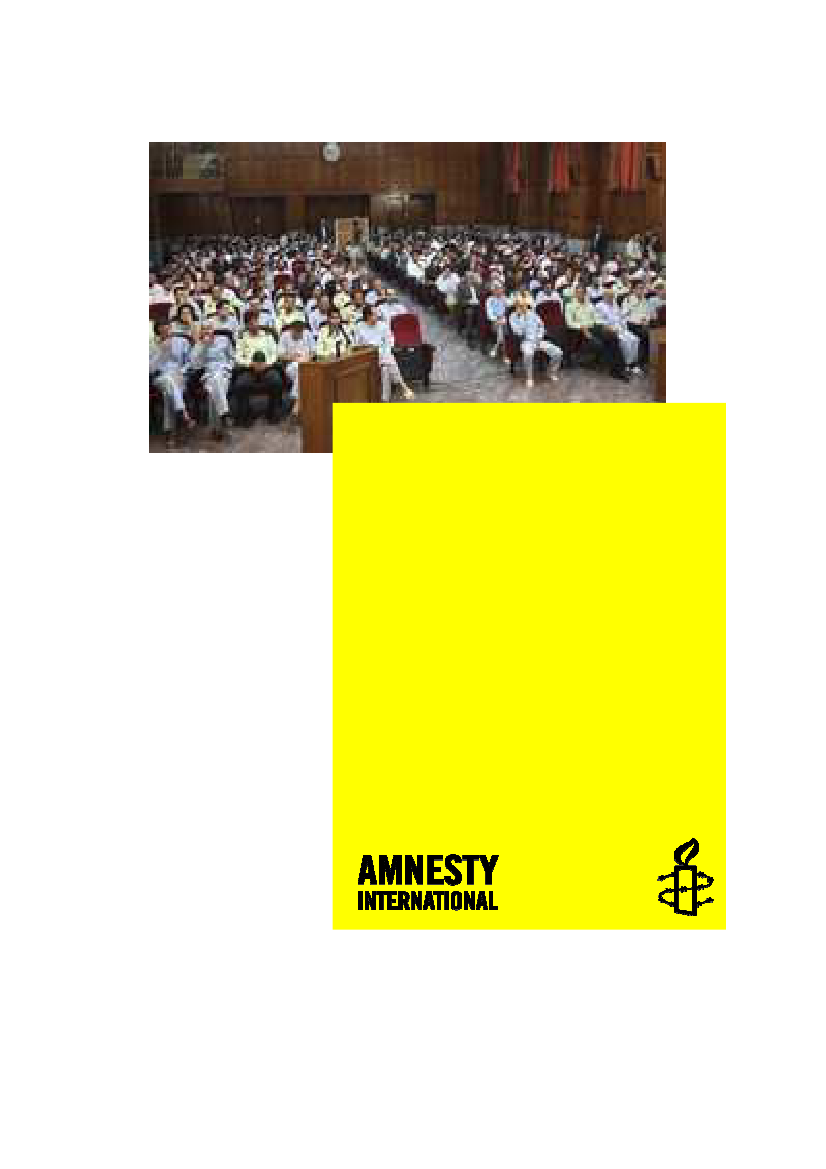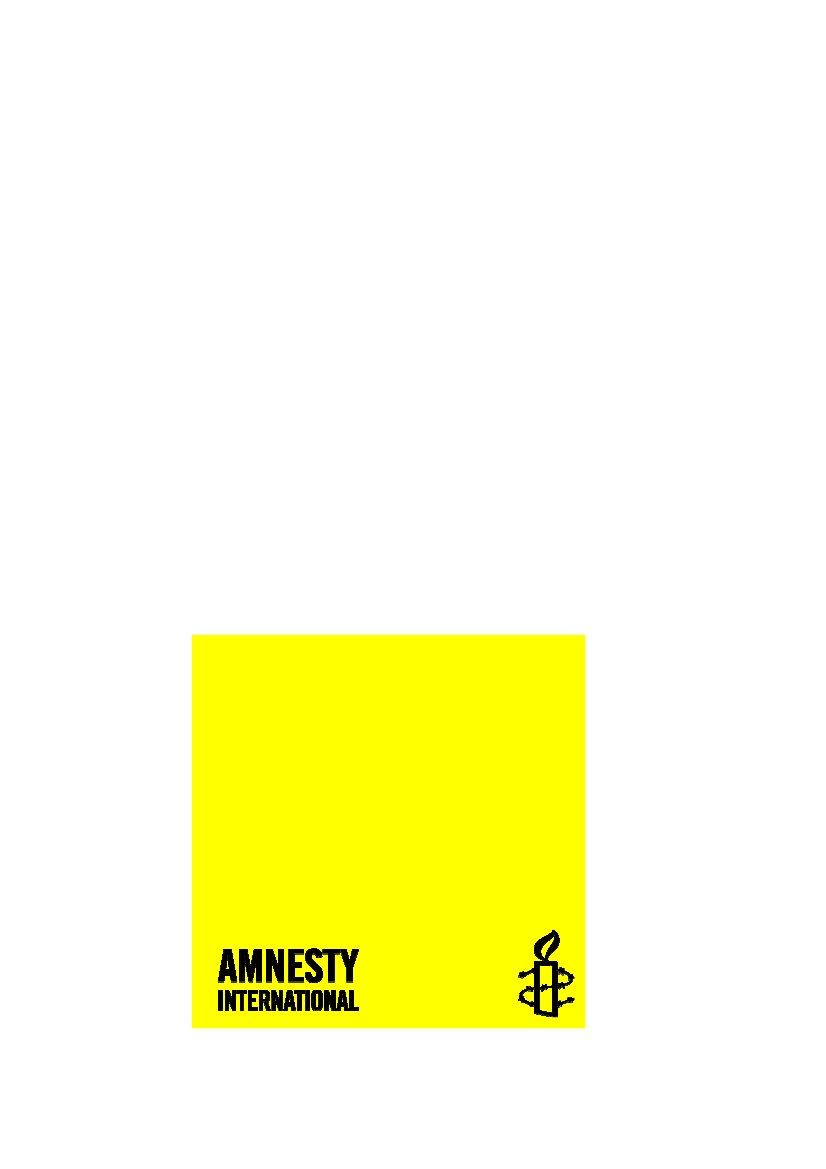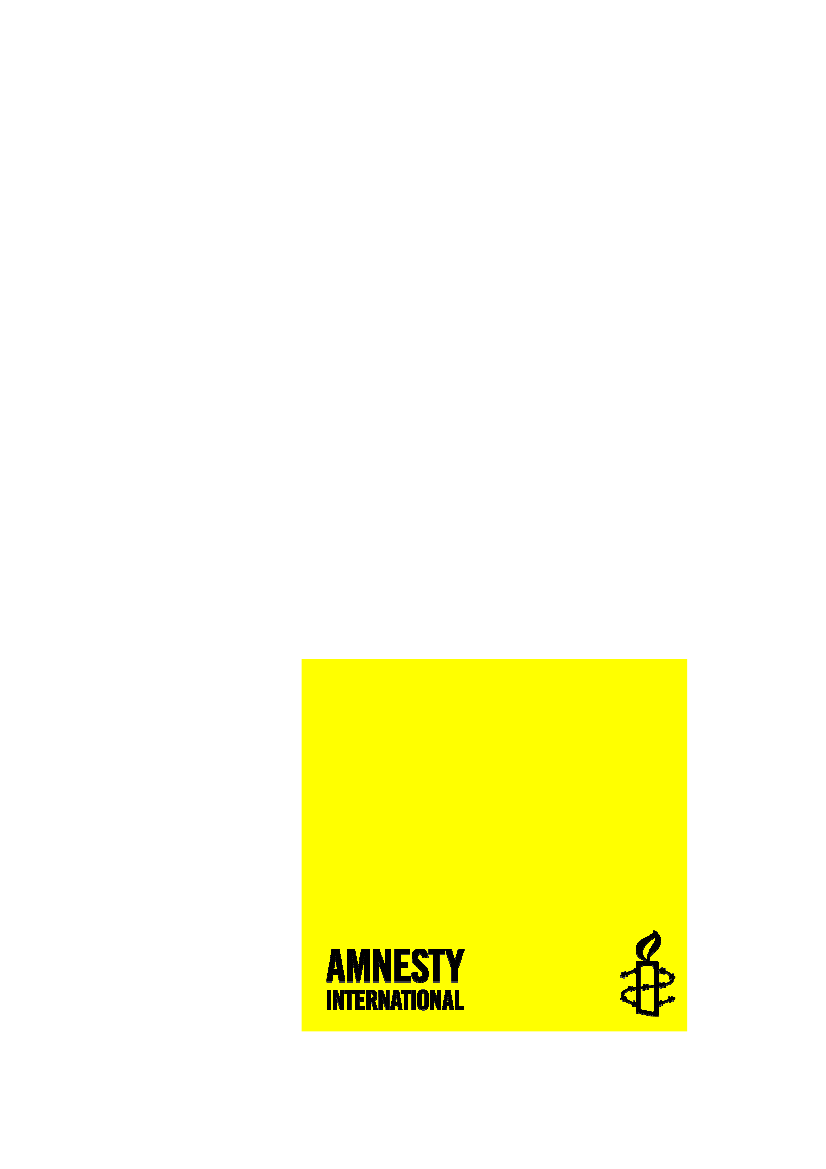Europaudvalget 2009-10
EUU Alm.del Bilag 429
Offentligt
FROM PROTESTTO PRISONIRAN ONE YEAR AFTERTHE ELECTION
Amnesty International PublicationsFirst published in 2010 byAmnesty International PublicationsInternational SecretariatPeter Benenson House1 Easton StreetLondon WC1X 0DWUnited Kingdomwww.amnesty.org�Copyright Amnesty International Publications 2008Index: MDE 13/062/2010Original Language: EnglishPrinted by Amnesty International, International Secretariat, United KingdomAll rights reserved. No part of this publication may be reproduced, stored in a retrieval system, or transmitted, in any formor by any means, electronic, mechanical, photocopying, recording or otherwise without the prior permission of thepublishers.Cover photo: Tehran's Revolutionary Court, 26 August 2009.� ASSOCIATED PRESS
Amnesty International is a global movement of 2.2 millionpeople in more than 150 countries and territories, whocampaign on human rights. Our vision is for every person toenjoy all the rights enshrined in the Universal Declaration ofHuman Rights and other international human rightsinstruments. We research, campaign, advocate and mobilizeto end abuses of human rights. Amnesty International isindependent of any government, political ideology, economicinterest or religion. Our work is largely financed bycontributions from our membership and donations
CONTENTS1. Introduction .............................................................................................................52. Who are the prisoners? ..............................................................................................8Political activists .......................................................................................................9Students and graduates............................................................................................10Journalists ..............................................................................................................12Filmmakers and other artists.....................................................................................13Rights defenders .....................................................................................................13Lawyers ..................................................................................................................16Clerics ....................................................................................................................17People linked to members of banned groups...............................................................17Members of ethnic and religious minorities ................................................................18Workers and members of professional bodies ..............................................................20Family members of prominent figures and detainees ...................................................213. Arbitrary arrest and detention ...................................................................................22Detention without charge or trial ...............................................................................24Unacknowledged detention amounting to enforced disappearance ................................25Iran’s detention centres and prisons ..........................................................................26Evin Prison ..........................................................................................................28Access to family members and legal representatives ....................................................304. Torture and ‘confessions’ .........................................................................................33
Rape and other sexual abuse .................................................................................... 35Threats against family members................................................................................ 36Poor prison conditions and denial of medical care ...................................................... 36‘Confessions’ .......................................................................................................... 385. Trials: the final gloss on a system of injustice ............................................................ 40Laws that restrict basic freedoms .............................................................................. 42‘Show trials’ – a travesty of justice ............................................................................ 43Evin Prison’s court .................................................................................................. 44Politically motivated use of the death penalty............................................................. 456. Impact on families.................................................................................................. 487. Impunity................................................................................................................ 508. Life in exile............................................................................................................ 539. Conclusion and Recommendations ........................................................................... 56Endnotes ................................................................................................................... 58
From protest to prison: Iran one year after the election
5
1. INTRODUCTION“The prisoner’s worst nightmare is the thought ofbeing forgotten.”Maziar Bahari, Iranian-Canadian journalist, after his release from four months of detention in Evin Prison1
One year on from the disputed presidential election of June 2009, Iranians who want tocriticize the Government or protest against mounting human rights violations face an ever-tightening gag as the authorities and the shadowy intelligence services – shaken to the core bythe events which followed – consolidate their grip on the country and intensify the repressionalready in place for years. Iranians have moved from protest to prison, as the authorities resortto locking up hundreds of people in a vain attempt to silence voices peacefully expressing adissenting view to the narrative which the authorities wish to provide of the election and itsaftermath.Thousands of people – over 5,000 according to official statements, although the true figure isalmost certainly higher – have been arrested during mass demonstrations which first eruptedon13 June 2009, the day after the election. Demonstrations took place steadily throughoutJune until mid-July 2009 in spite of the authorities’ determination to quell protests, thencontinued more sporadically on days of national importance, whenever public demonstrationswere permitted.2At the time of writing, demonstrations which took place during the religiousfestival of Ashoura, which fell on 27 December 2009, were the last mass demonstrations tooccur since the election, when over 1,000 people were arrested, according to official figures.Attempts to hold further demonstrations on 11 February 2010, the anniversary of the foundingof the Islamic Republic were prevented by the heavy presence of security forces. Most of thosearrested have been released, although some have returned to prison to begin serving prisonsentences, but may also spend short periods free on “temporary leave”. These “revolving prisondoors” make it difficult to give precise numbers of those held at any one time.Those who demonstrated against the Government were met by security forces wielding batons,using tear gas and sometimes firing live rounds.3Hundreds of others have been arrested attheir homes or workplaces, usually by unidentified plain clothes officials bearing generic arrestwarrants. Some have been detained in conditions amounting to cruel, inhuman and degradingtreatment. Many have been tortured, including by beatings, rape and solitary confinement insmall spaces for long periods. Hundreds have been sentenced after grossly unfair trials tolengthy prison sentences, while many others are still held without charge or trial. Some havebeen sentenced to death.At the same time, the Iranian authorities have passed new laws to restrict people writing onwebsites and established new security bodies to monitor web content. They have criminalizedcontact with over 60 foreign institutions, media organizations and NGOs – a move which canonly be construed as an attempt to isolate Iranians and prevent news, including on humanrights violations, from leaving the country.4They have continued to close down newspapers thatare deemed to cross the ever-shifting “red line” of what they consider to be acceptable.Websites and email services have been filtered or blocked and the police have warned that
Index: MDE 13/062/2010
Amnesty International June 2010
6
From protest to prison: Iran one year after the election
SMS messages are monitored.5They have fired many university professors and staff on thegrounds that they do not have sufficient “belief” in the Islamic Republic. Renewed efforts toimplement “morality” codes concerning dress and gender segregation are underway whichparticularly impede women’s ability to function freely in society. They have issued numerousthreatening statements and executed political prisoners to make it absolutely clear that thosewho express any form of dissent – whether by speaking out or writing or attendingdemonstrations – will face the harshest penalties.“I hope your daughters grow up to get married – mine grew up to be thrown into jail”. So saidthe mother of Shiva Nazar Ahari, one of the detainees whose case is highlighted in this report,to Amnesty International – poignantly illustrating the journey taken by an increasing number ofIranians, from political and civil activism and street demonstrations to the cells of Evin Prisonand beyond. This report describes that journey in detail, showing how ordinary an experiencearrest and detention has become. Iranians in large numbers are being imprisoned for peacefullyexercizing their rights. Not only should they not be incarcerated in the first place, but whileheld they are further abused and victimized. The report clearly demonstrates that the vastmajority of international standards related to the protection of detainees, as set out in the UNBody of Principles for the Protection of All Persons under Any Form of Detention orImprisonment, are ignored. Judicial guarantees in Iranian law are also routinely flouted.Over the past year, Iran has faced mounting international criticism of its human rights recordboth by individual states and within international fora such as the United Nations GeneralAssembly and the Human Rights Council, where Iran’s record was considered in the frameworkof the Universal Periodic Review (UPR) in February 2010. While accepting genericrecommendations at the conclusion of the process, other specific recommendations wererejected, which had they been adopted and implemented could have significantly improved thesituation for detainees and prisoners in Iran. Consolidated international pressure on Iran in therun up to the election in May for membership of the Human Rights Council appears to have ledto the withdrawal of Iran’s candidacy at the last minute.At times, the reality of the situation for prisoners in Iran has been on the lips of the world, suchas the campaign for the release of renowned film director Ja’far Panahi which culminated inhis empty chair on the jury for the Cannes Film Festival. However, his welcome release shouldnot obscure the fact that hundreds of others remain held – for similar reasons – who have noone to speak so eloquently for them.This report is an attempt to address that fact and to ensure that the worst nightmare ofreleased detainee Maziar Bahari does not become a reality for those still held. It focuses on thesituation of detainees and prisoners in Iran – most of whom are prisoners of conscience6whoshould be released forthwith – while recognizing that many other egregious human rightsviolations in Iran deserve attention in their own right. It looks at the people targeted for arrest,who are drawn from a widening circle of the population, how arrests are made, where detaineesare held, the conditions of detention, and the pressures placed on detainees to make“confessions” that are then used as the main evidence against them in trials which arefundamentally flawed and are often summary, particularly in the provinces away from the glareof publicity in Tehran.The report analyses the vaguely worded legislation used to charge those arrested with“offences” that do not meet the requirements for clarity and precision in criminal law outlinedin international law. It looks at the political pressures exerted on judges to convict people, andthe politically motivated use of the death penalty to send a warning to anyone considering opendefiance of the authorities.
Amnesty International June 2010
Index: MDE 13/062/2010
From protest to prison: Iran one year after the election
7
The report ends with two essential calls on the Iranian authorities to immediately andunconditionally release all prisoners of conscience and to ensure that all other politicalprisoners are tried promptly and fairly, without recourse to the death penalty, in proceedingswhich fully meet international fair trial standards.Despite Iran’s assertion in its report submitted to the United Nations in the framework of theUPR in February 2010 that it co-operates with NGOs, Amnesty International has not beenpermitted to visit Iran for fact-finding purposes or to hold Government talks since 1979. Theorganization again sought access to Iran in November 2009, and was unable to even meet theAmbassador of Iran in London. Amnesty International delegates also sought a meeting with theIranian delegation presenting Iran’s human rights record at the UN for the Universal PeriodicReview of Iran in February 2010, but were rebuffed.This report is therefore based on interviews with family members of those held; their lawyersand friends; those who have been released, including some interviewed face-to-face in Turkeyin March 2010; statements by the Iranian authorities; media reports, both official and from theopposition; and reports by local and international NGOs concerned with human rights. AmnestyInternational’s lack of access to Iran has affected the ability of the organization to verifydirectly all violations brought to its attention. However, it believes the wide range ofinformation below illustrates the plight of the hundreds of people detained without charge ortrial, or sentenced to lengthy prison terms, flogging or death after unfair trials simply forexpressing their dissenting views.The report follows an earlier report issued by Amnesty International in December 2009,Iran:Election contested, repression compounded,which documented human rights violations before,during and after the election up to mid-November 2009.7Amnesty International hopes thatthis report too will help break the wall of silence which the Iranian authorities are trying toerect, and will contribute to an eventual improvement in the human rights situation for all inIran. Alongside the publication of this report, the organization is launching a year-longcampaign, which will focus on the situation of a number of prisoners of conscience andpolitical prisoners to highlight the plight of the hundreds still held.Amnesty International wishes to thank all those who contributed to this report, and to paytribute to those who have allowed their stories to be told, in the hope that others may not sufferin the same way. In particular, the families and friends of detainees and prisoners who – at nosmall risk to themselves – have continued to speak out to ensure their loved ones are notforgotten, deserve our admiration. It has only been possible to mention a small proportion ofthose who are still suffering, but this is not to downplay the suffering of others – and weencourage all who have such information to come forward and speak out, so that no one isforgotten and so that the international community cannot turn a blind eye to the human rightsviolations which continue unabated in Iran.
Index: MDE 13/062/2010
Amnesty International June 2010
8
From protest to prison: Iran one year after the election
2. WHO ARE THE PRISONERS?“Silence has usually harmed, rather than helped,political prisoners.”Roxana Saberi, former prisoner of conscience,The Washington Post,13 May 2010
All those arrested, detained and imprisoned in the fallout after the election have one thing incommon: they are perceived as challenging the authorites’ legitimacy and in some way offeringan alternative view of events to that presented by the authorities.The vast majority of the well-over 5,000 arrested since June 2009 have been ordinary citizens– women and men, workers and the unemployed, students and professionals – who went outinto the streets to protest against the announced election result, or against human rightsviolations that occurred. Most were released after days or weeks, but some were held formonths. Some still languish in the harsh conditions prevalent in most of Iran’s prisons,particularly in the provinces. These are the “nameless” prisoners (gomnam) – the lesser-knownpeople whose cases have not garnered much media attention.8In addition to these prisoners, there have been sweeping arrests before and afterdemonstrations which since July have taken place only on days of national importance whenpublic demonstrations are generally held, such as Qods Day, the last Friday of Ramadan, theanniversary of the seizure of the US Embassy on 4 November 1979, National Students’ Day on7 December, and the religious festival of Ashoura (the 10th day of the Islamic month ofMoharram which fell on 27 December in 2009).Those targeted for arrest have included political and human rights activists, journalists,women’s rights defenders and students. As time has progressed, new groups have been broughtinto the fold of suspicion, including clerics, academics, former political prisoners and theirrelatives, people with family links to banned groups, members of Iran’s ethnic and religiousminorities−particularly the Baha’is, but also other minorities such as Christians, Dervishes,Azerbaijanis, Sunni Muslims(whoare mostly Baluch and Kurds), and lawyers who havedefended political detainees.Amnesty International has been unable to compile and maintain complete lists of all thosecurrently detained or imprisoned. This is due to the secrecy surrounding arrests, includingpressures placed on families not to report arrests; the difficulty of obtaining information fromIran, where the security services monitor phone calls, email and other internet-based forms ofcommunication; and the “revolving doors” of prisons and detention centres, whereby peopleare detained for relatively short periods, sometimes repeatedly, or prisoners are releasedpending appeal or “temporarily” for weeks or months. However, a small number of individualswhose cases have been brought to the organization’s attention are highlighted below toillustrate the pattern of violations against those held.
Amnesty International June 2010
Index: MDE 13/062/2010
From protest to prison: Iran one year after the election
9
POLITICAL ACTIVISTS"These two parties [the Islamic Iran Participation Front and the Mojahedin of the Islamic RevolutionOrganization] played an important role in [post-] poll seditions, thus the system, to prove its power,should act firmly with the transgressors."Ruhollah Hosseinian, Head of the Domestic Policy and Councils’ Affairs Committee of the Majles, in April 2010 following the banningof two parties9
While the two main opposition leaders – unsuccessful presidential candidates Mir HosseinMousavi and Mehdi Karroubi – remained at liberty at the time of writing, they have facedthreats of arrest, and their movements and whom they meet are closely monitored.10MehdiKarroubi’s car has been attacked, one of his sons was banned from leaving the country, andanother was arrested and beaten during a rally held on the anniversary of the establishment ofthe Islamic Republic on 11 February. Mir Hossein Mousavi’s nephew was killed in the Ashourademonstrations, and his personal bodyguard was arrested in mid-May 2009.However, many senior members of political parties such as the Islamic Iran Participation Front(IIPF), a political party linked to former President Mohammad Khatami, and the Mojahedin ofthe Islamic Revolution Organization (MIRO), which endorsed Mir Hossein Mousavi’s candidacyin the 2009 presidential election, were arrested in the days after the election. The two partieshave since been banned.11Arrests have continued – for example, former parliamentarianMohsen Armin,a spokesperson and senior member of MIRO, was arrested from his home on 16May 2010.Other parties whose members have been targeted for arrest include the Servants ofConstruction (SOC), which is close to former President and Chair of the Expediency CouncilAyatollah Akbar Hashemi Rafsanjani; the National Trust party, headed by Mehdi Karroubiwhich was closed down in August 2009; and the banned but tolerated Freedom Movement, ledby Ebrahim Yazdi. Many were later sentenced to prison terms, but some had been freed on bailpending appeal or for “temporary prison leave” at the time of writing. They includeAzarMansouri,a senior member of the IIPF, as well asAbdollah Ramazanzadeh,the party’s DeputyChairman, sentenced to three years and six years in prison respectively and both released onbail. Others currently at liberty areMohammad Atrianfar,a journalist and member of the SOCwho was sentenced to six years’ imprisonment in November 2009, but released on bailpending an appeal.The liberty of those released conditionally is precarious.Mohsen Mirdamadi,for example, theChairperson of the IIPF, was returned to prison on 26 May 2010 after his release on bail twomonths earlier in March. He was sentenced in April to six years in prison.Behzad Nabavi,aformer Deputy Minister, parliamentarian and founding member of MIRO, returned to prison inlate May 2010 to continue serving a five-year prison term after having been releasedtemporarily on 16 March 2010.Hengameh Shahidi,a journalist and member of the NationalTrust party who acted as an adviser on women’s issues to defeated presidential candidateMehdi Karroubi during his election campaign, began serving a six-year prison sentence on 25February 2010 after an appeal court upheld the conviction on charges related to her politicaland journalistic activities. Hengameh Shahidi, who is in poor health, had been arrested on 30June 2009 and released on bail in November.Others have never been released and remain imprisoned. Among them isFarid Taheri,amember of the Freedom Movement, arrested in January 2010 and sentenced to three years inprison in April 2010 for “gathering and colluding with intent to harm state security”,“propaganda against the system and “disturbing public order”.
Index: MDE 13/062/2010
Amnesty International June 2010
10
From protest to prison: Iran one year after the election
Members of smaller political parties have also been targeted.Heshmatollah Tabarzadi,aged53, leader of the banned Democratic Front of Iran, was arrested on 27 December 2009 at hishome in Tehran after the Ashoura protests. He has been held since then without charge or trialor access to a lawyer. His arrest may be linked to some of his articles and interviews whichappeared before and during the Ashoura unrest.Some activists have been arrested several times.Emad Bahavar,Head of the Youth Wing of theFreedom Movement, which was active during the presidential campaign, has been arrested fourtimes since the start of 2009 apparently in connection with the election, including thecampaign beforehand.Most recently he was arrested in March 2010 when he was summonedto court only days after being released. He was mentioned in the second mass “show trial” ofAugust 2009, during which the Freedom Movement was accused of being part of the “softrevolution” which the authorities claimed was aimed at overthrowing the Islamic Republic.Held without charge or trial, he was said to be under pressure to make a televized “confession”at the time of writing.Many other members of political parties, especially from provincial branches, have beenarrested in the months following the election – such asDr. Hossein Raisian,a universityProfessor and member of the Qazvin branch of the IIPF, who was arrested in May 2010.Officials later said that he had been arrested on suspicion of an illicit relationship, but DrRaisian later reportedly told his wife that these accusations were untrue and were politicallymotivated. For the majority, even when reports of their arrests have surfaced, their fates remainlargely unknown, highlighting the extra layer of secrecy surrounding those detained in theprovinces.
STUDENTS AND GRADUATESMembers of the student body, the Office of the Consolidation of Unity ( Daftar-e Tahkim-eVahdat, OCU), and the Graduates’ Association (Advar-e Tahkim-e Vahdat) have been targetedfor arrest. Both organizations have been prominent in promoting human rights, reporting onhuman rights violations and calling for political reform in recent years.Members of the OCU Central Committee currently held includeBahareh Hedayat,also Chair ofthe OCU’s Women’s Committee, andMilad Asadi.In May 2010 they were sentenced to nineand a half years and seven years in prison respectively. Bahareh Hedayat’s husband, AminAhmadian described how their trials were held behind closed doors without their lawyers beingpresent and added:"This ruling has no legal basis and has been issued on a political basis. On the threshold of theanniversary of the elections and the attack on the Tehran University dormitories, I think theywanted to issue heavy sentences for two distinguished student activists”.12Morteza Samyari,aged 24, another member of the Central Committee, was released on bail inFebruary 2010, pending an appeal. Arrested on 4 January 2010, he was sentenced to six yearsin prison after he was convicted of “propaganda against the system” and “gathering andcolluding with the intent to act against national security”, following a “show trial” that beganon 30 January 2010 (see Chapter 5).Mehdi Arabshahi,Secretary of the OCU, arrested afterthe Ashoura demonstrations on 27 December, was released on bail on 11 March 2010 and hasyet to be tried.Student leaderMajid Tavakkoliwas beaten and arrested on 7 December 2009 after making aspeech at a student demonstration in Tehran. His lawyer was not permitted to attend his trial,which took place in January 2010, after which he was sentenced to eight-and a half years inprison. He was also issued a five-year ban on any involvement in political activities and on
Amnesty International June 2010
Index: MDE 13/062/2010
From protest to prison: Iran one year after the election
11
leaving the country. In May 2010 he went on hunger strike to protest at his transfer to solitaryconfinement until he was moved back to a general ward.The day after his arrest, the Fars News Agency, which is close to the Revolutionary Guards andthe Judiciary, published pictures of Majid Tavakkoli wearing women’s clothing, and said he hadbeen wearing them at the time of his arrest in order to escape detection. Student sources havedenied that he was wearing the clothes at the time, but suggested he was forced to wear themafterwards to humiliate him.After Majid Tavakkoli was pictured wearing women’s clothes, many Iranian men took picturesof themselves with head coverings, many of them holding signs saying “We are Majid”, andposted them on the internet as part of a solidarity campaign calling for his release.13The Graduates’ Association, comprised mainly of former students who had been active in theOCU while studying and which in recent years has promoted reform and greater respect forhuman rights, said in May 2010 that over half of its members had been arrested since theelection.They includeAhmad Zeidabadi,a journalist and Secretary-General of the Graduates’Association, who was arrested on 21 June 2009 and held incommunicado in Evin Prison untilhis appearance on 8 August 2009 at the second session of a mass “show trial”. He wassentenced to six years’ imprisonment in November 2009, five years of internal exile in the cityof Gonabad, and a lifetime ban on all social and political activities. At the end of January2010, he was transferred to Raja’i Shahr Prison in Karaj, near Tehran, where most non-political prisoners are housed. Even though his family posted bail, he has not been freed.Another senior member of the Association,Abdollah Momeni,who also appeared in a “showtrial” in August, was sentenced to six years’ imprisonment in November 2009, and a previouslysuspended sentence of two years’ imprisonment was also implemented. In May 2010, this wasreduced to four years and eleven months on appeal. Also in May,Kohzad Esma’ili,the Head ofthe organization’s Gilan branch, had his three-year sentence upheld on appeal. Others havebeen released on bail, includingSalman Sima,but some have been banned from leaving thecountry, such asHasan Asadi ZeidabadiandMohammad Sadeghi.Both had been arrested inNovember 2009.Hundreds of students who have participated in demonstrations in the streets or on universitycampuses have been arrested and some have been sentenced to prison terms. For example,Amnesty International obtained court documents relating to the trial of eight students, allmembers of the Islamic Society in the Babol Noshirvani University of Technology, northernIran. They were found guilty in September 2009 of acting against the Islamic Republic by“participating in an illegal gathering”, “encouraging people to riot” and “propaganda againstthe state”. In February 2010, a court of appeal upheld the sentences ofIman Sedighi, MohsenBarzegarandNima Nahavito 10 months in prison.Mohsen Esma’ilzadehhad his 91-dayprison sentence for “insulting the Supreme Leader” upheld. Five others were sentenced to 10months’ suspended imprisonment and a one-year ban on studying. At the time of writing, ImanSedighi, Mohsen Barzegar, Nima Nahavi and Mohsen Esma’ilzadeh were all serving theirsentences in Mati Kalay Prison in Babol.
Index: MDE 13/062/2010
Amnesty International June 2010
12
From protest to prison: Iran one year after the election
JOURNALISTS“This year, we bloggers and journalists are celebrating World Press Freedom Day in prison. We havebeen jailed and given unjust sentences for wanting to inform, for writing articles, for carrying outinterviews and for participating in the debate about freedom and democracy. Purely and simply fordoing our duty as journalists.”Open letter from 20 detained journalists for World Press Freedom Day 201014
Journalists have been particularly targeted, perhaps because it is in the very nature of theirwork to uncover the truth and comment on events. Well over 100 journalists, many of whomworked for publications perceived by the authorities as “reformist”, are believed to have beenarrested, and over 5015of them remain detained or imprisoned or on temporary leave at risk ofreturn to prison at the time of writing. There are frequent reports of further arrests, in additionto the banning of publications – over 20 since the election – which has left an estimated3,000 people without work.16Some of those sentenced are free on bail pending appeal or on “temporary” release, such asSaeed Laylaz,sentenced to six years. Like others, some journalists released temporarily haveexperienced the fragility of their freedom:Bahman Ahmadi Amou’i,whose seven year and fourmonth sentence was reduced to five years on appeal, returned to prison in late May 2010 after72 days, Others have never been released and are serving heavy prison sentences, such asMasoud Bastani,a journalist forJomhouriyat,who was arrested in July 2009. He is serving asix-year prison sentence in harsh conditions at Raja’i Shahr Prison, in Karaj, near Tehran.Mehdi Mahmoudian,a journalist who first revealed abuses at the Kahrizak Detention Centre17and was arrested on 16 September, was sentenced to five years in prison in May.Still others have yet to be charged or tried, despite having spent months in detention. Manyhave been held in solitary confinement in prisons where they risk torture or other ill-treatment,including beatings, threats and mock execution. They include veteran journalistIsa Saharkhizwho was active in Mehdi Karroubi’s election campaign, and who has been detained withoutcharge or trial for over 11 months. He was transferred to Raja’i Shahr Prison in May, which hisfamily consider to be a form of punishment.Prominent human rights defender and journalistEmadeddin Baghi– the 2009 recipient of theprestigious Martin Ennals Award for human rights defenders – was arrested on 28 December.In November he had been banned from travelling to Geneva to accept the award, the first timein the award's 18-year history that the recipient was denied the opportunity to receive theaward in person. His arrest followed the broadcasting several days previously of an interview hehad recorded two years earlier with Grand Ayatollah Montazeri, which was shown on BBCPersian TV to mark the cleric’s death.18He was arrested at a time of mass protests in Tehranand other cities to mark Ashoura. He remains held without charge.Badrolsadat Mofidi,Secretary of the now-banned Association of Iranian Journalists, wasarrested after the Ashoura demonstrations following an interview she had given a week earlierto the German international broadcaster Deutsche Welle in which she described the crackdownon the press. She remains held without charge or trial at the time of writing.All three are suffering ill-health in detention and there are fears that the medical care they arereceiving is inadequate.
Amnesty International June 2010
Index: MDE 13/062/2010
From protest to prison: Iran one year after the election
13
FILMMAKERS AND OTHER ARTISTS“Specific Iranian productions might not receive permission for a foreign premiere… One [filmmaker]was recently warned against any attempt to screen his movie at foreign festivals.”Alireza Sajjadpur,Director of the Ministry of Culture and Islamic Guidance’s Supervision and Evaluation Office, April 201019
Those involved in culture have not been immune from arrest or harassment, particularly whenthe authorities fear that the art will be used to present a dissenting voice to the world.Screenplays must be vetted by the Ministry of Culture and Islamic Guidance to receive aproduction licence and then a screening licence for both domestic and foreign showings. InMay 2010, a Ministry of Culture official said that Iranians must also obtain permission beforeco-operating in foreign productions.20Celebrated movie directorJa’far Panahiwas released on 25 May 2010 after almost threemonths in detention without charge or trial, after his plight was highlighted at the Cannes FilmFestival.Mohammad Nourizad,a director as well as a journalist, was on hunger strike at thetime of writing after he was beaten in prison. He was arrested in December 2009 andsentenced to three and a half years’ imprisonment and 50 lashes for “insulting the authorities”and “propaganda against the state” for articles published on his blog criticizing the SupremeLeader and the Head of the Judiciary.His sentence was upheld on appeal in late May, shortlyafter he described being pulled from his cell without warning and beaten – possibly in reprisalfor a letter to the Supreme Leader which he wrote in April 2010, criticizing his treatment andimprisonment.21Mohammad Ali Shirzadi,a documentary filmmaker, was held without charge or trial at the timeof writing. His arrest in December is believed to be linked to an interview he filmed betweenprominent human rights defender Emadeddin Baghi and Grand Ayatollah Montazeri. Since hisarrest, Mohammad Ali Shirzadi has had around three family visits and no access to his lawyer.Other artists detained includeMehraneh Atashi,an internationally-renowned photographer whowas arrested with her husbandMajid Ghaffariin January. They were released on bail in March2010. Some have been harassed, including 82-year-old poetSimin Behbahaniwho wasbanned from travelling to France in March where she was due to speak at an InternationalWomen’s Day event.
RIGHTS DEFENDERS“As far as we understand from our daughter’s writings and activities, she has not done anything exceptsome human rights activities. In her attempts to realize this goal, she does her best to defend everyreligion and ideology. Is it a crime to defend human rights?”Shiva Nazar Ahari’s parents in a letter to the Ministry of Intelligence after her arrest in December 2009
The Iranian authorities have been keen to discredit human rights activists, including citizenjournalists who have been at the forefront of gathering information about human rightsviolations, including testimonies from families and occasionally from released prisoners. In anapparent attempt to provide scapegoats for their distorted version of events, the authoritieshave accused some human rights NGOs of being in contact with, or supplying information to,banned groups, particularly the People’s Mojahedin Organization of Iran (PMOI) and havecarried out waves of arrests of human rights activists.For example, at least eight members of the Committee of Human Rights Reporters (CHRR)have been arbitrarily arrested since the end of November 2009. Two of them –Shiva NazarAhariandKouhyar Goudarzi– were still detained in May 2010. Their trials had begun, but hadnot been concluded. Others arrested and later released includeSaeed Kalanaki, Saeed
Index: MDE 13/062/2010
Amnesty International June 2010
14
From protest to prison: Iran one year after the election
Jalalifar, Saeed Haeri, Parisa Kakayi, Mehrdad RahimiandNavid Khanjani.Some membershave fled the country for their own safety. In January 2010 the Tehran Prosecutor accused thegroup of having links to the PMOI, and said that “any collaboration with the [CHRR] is acrime”. The CHRR vehemently denies having such links.Another human rights organization, Human Rights Activists in Iran (HRAI), has also beentargeted. In early March 2010, a wave of arrests of individuals who are or have been associatedwith the organization was carried out. Many of those arrested remained held at the time ofwriting. On 17 March 2010, the Tehran Prosecutor’s Office said that 30 people had beenarrested in connection with alleged US Central Intelligence Agency (CIA) “cyber networks” thatwere aimed at destabilizing Iran, and said that HRAI was part of this. On 26 March 2010, theHRAI published a list of 41 of its members and associates who it said had been arrested. Itsaid “the only crime of these activists is their philanthropy and their work toward helpinghumanity”.22They includeMahboubeh Karami(who is also a member of the One MillionSignatures Campaign−see below) andAbdolreza Ahmadifrom Tehran;Mohammad Reza LotfiYazdifrom Mashhad;Mojtaba Bayatfrom Qom;Tahmineh Momenifrom Sari;Sepehr Soufifrom Kish Island;Somayeh Ojaghloufrom Esfahan; andMojtaba Gahestounifrom Ahvaz; andSaleh Shalmashifrom Sanandaj. Some of them have since been released.Abolfazl Abedini Nasr,a 28-year-old journalist and human rights activist from Ramhormuz,Khuzestan province, who was formerly a Press Officer for the HRAI, has been particularlyharshly treated. He was first arrested in late June 2009 and was held for four months inSepidar Prison, in Ahvaz, near Iran's border with Iraq, until he was released on bail on 26October 2009. On 3 March 2010, during a wave of arrests of human rights activists, he wasrearrested at his home in Ramhormuz. During his arrest he was beaten by security officials.Four days after this arrest, he was taken to Evin Prison, where he is also reported to have beenbeaten.After his rearrest, Abolfazl Abedini Nasr’s lawyer was informed on 29 March 2010 that hisclient had been sentenced to 11 years in prison in connection with his earlier arrest in June2009. This consisted of five years’ imprisonment for “membership of an illegal organization”,in relation to his involvement with the HRAI, one year’s imprisonment for “propaganda againstthe system” for talking to foreign media and five years for “contacts with enemy states”. The“contact with enemy states” may be related to claims that the authorities made in March 2010that the HRAI was set up by the CIA as part of alleged attempts to orchestrate a “softrevolution” in Iran. His sentence was confirmed on appeal in May 2010. He suffers from aheart defect which requires regular medication and check-ups.Sayed Ziaoddin Nabaviisa member of the Council to Defend the Right to Education, a body setup in 2009 by students barred from further study because of their political activities or on accountof their being Baha’is. He was arrested in June 2009, along with his cousin Atefeh Nabavi whowas later sentenced to four years in prison. Sayed Ziaoddin Nabavi was sentenced to 15 years’imprisonment and 74 lashes in January 2010, which was reduced to 10 years on appeal in lateMay. He says that he was beaten, kicked, insulted and humiliated during his interrogation. Hisparticularly heavy sentence appears in part to be linked to the fact that he has family membersbased in PMOI-run camps in Iraq. He denies having any personal links to the PMOI.Members of other human rights organizations have also been arrested, and some tried andsentenced.Ali Bikas,a member of the Student Committee for the Defence of PoliticalPrisoners (SCDPP) and an activist for the rights of the Iranian Azerbaijani minority, is serving aseven-year prison term in Evin Prison. Another member of the SCDPP,Naseh Faridi,wassentenced to six years in prison and 74 lashes in January. He is currently free on bail pendingan appeal. Another board member of the SCDPP, lawyerMohammad Olyaeifardis also
Amnesty International June 2010
Index: MDE 13/062/2010
From protest to prison: Iran one year after the election
15
imprisoned (see section on lawyers below).Kaveh Ghasemi Kermanshahi,spokesperson for theHuman Rights Organization of Kurdistan23and a member of the One Million SignaturesCampaign which campaigns for greater respect for women’s rights, was arrested in February2010 in Kermanshah, western Iran. He was released on bail on 23 May 2010.Children’s rights activists have not been spared either: for example,Maryam Zia,Director of theAssociation for the Endeavour for a World Deserving of Children, was arrested on 31 December2009. She was eventually released on bail in March 2010 after she had gone on hunger strikein protest at her continued detention. Women campaigning for redress for human rightsviolations have also been targeted: members of the Mourning Mothers, a group of motherswhose children were killed in the post-election demonstrations and their supporters, have beenarrested on several occasions. Members of the group meet silently in parks on Saturdays toregister their protests. Over 30 were arrested in January, although most were released withindays.24Women’s rights defenders too have faced the authorities’ ire. Although immediately after theelection there was a lull in arrests of women’s rights activists, the women’s movement wasnamed in the general indictment read at the first “show trial” as being part of the “velvetrevolution” and arrests resumed in October.Shadi Sadr,a prominent lawyer and women’srights defender who was detained for a week in July 2009, was sentenced in her absence to sixyears in prison and 74 lashes along withMahboubeh Abbasgholizadeh,another women’s rightsdefender, who was sentenced to two-and-a-half years’ imprisonment and 30 lashes.25Bothwere convicted in relation to a peaceful gathering in 2007 – a move widely interpreted asintended to discourage people from protesting on the anniversary of the election.Among those particularly targeted have been supporters of the One Million SignaturesCampaign (also known as the Campaign for Equality), a women’s rights initiative launched in2006. Its volunteers are collecting a million signatures of Iranians demanding an end to legaldiscrimination against women in Iran, such as exclusion from key areas of the state, includingstanding for the presidency, and in the areas of marriage, divorce, child custody andinheritance. Even though the Campaign for Equality conducts its activities in full compliancewith the law, the authorities have impeded its work and repressed its activists. They haveblocked access to the campaign’s main website at least 23 times, frequently denied the grouppermission to hold public meetings, prevented activists from travelling abroad or summonedthem for interrogation, and apparently been behind threatening phone calls.More than a dozen members of the Campaign for Equality have been arrested since October2009. They includeRahaleh AsgarizadehandVahideh Molavi,arrested during protests inTehran on 4 November 2009, and two men,Mohsen Parizad MoghaddamandAli Mashmooli,arrested in Esfahan, central Iran, on the same day. All were later released.Mehrnoush Etemadiwas arrested at home in Esfahan on 23 November 2009 and was releasedon bail in December. Accusations made against her included “membership of the One MillionSignatures Campaign”.Hayedeh Tabeshwas arrested on 5 December 2009, also in Esfahan.Both were released on bail on 8 December. Hayedeh Tabesh had previously been banned fromtravel abroad because she had been invited to a training event in South Africa, even though shedid not participate in the event.Other Campaign members arrested after Ashoura includeAtiyeh Yousefi,held for about twoweeks in the northern city of Rasht;Somayeh Rashidi,arrested in December and held for 68days; andMansoureh Shojaee,held for almost a month in Tehran. Mansoureh Shojaee hasbeen banned from travel for the past three years.
Index: MDE 13/062/2010
Amnesty International June 2010
16
From protest to prison: Iran one year after the election
Others were arrested in the run-up to the anniversary of the Islamic Revolution in February2010. They includeMaziar Samiee,a student and Campaign for Equality activist. He was heldfor two weeks in February 2010.Mahsa Jazini,a journalist forIran Dailyand an activist in theCampaign for Equality, was arrested on 7 February 2010 in Esfahan and released on bail on 1March. She was told at the time of her arrest that the reason for her detention was that she wasa feminist.Noushin Ja’fari,another journalist, was also held for about a month after her arrestin early February 2010.Dorsa Sobhani,a Campaign for Equality member in Sari, near the northern Caspian Sea coast,was arrested on 7 March 2010 and held until 21 April. A member of the Baha’i minority, shehad been banned from continuing her university studies on account of her faith, and afterwardsjoined the Council to Defend the Right to Education.Somayeh Farid,a Campaign activist whois also a member of the Graduates’ Association, was arrested in Tehran on 16 March 2010when she went to inquire about her husband who had been arrested. She was released on bailafter almost two weeks.
LAWYERS“Given that my sister has always defended legal rights of students and political activists, it is mostupsetting that she is now deprived of her own legal rights.”Hossein Mirzaei, the brother of Forough Mirzaei, during her detention in January 201026
The Iranian authorities appear to be taking measures to limit the access of Iranians to high-quality, independent legal representation. In addition to measures to limit the independence ofthe Iranian Bar Association, such as barring candidates from standing for election to seniorpositions on discriminatory grounds, including their imputed political opinions, several lawyershave also been arrested, apparently on account of their work or their political beliefs.Mohammad Olyaeifard,who has defended cases of juvenile offenders as well as imprisonedjournalists and trade unionists (he is the lawyer of Abolfazl Abedini Nasr mentioned above),was arrested on 1 May 2010 to begin serving a one-year jail term imposed for “propagandaagainst the system”. His lawyers have not been informed of his sentence, in violation of Iranianlaw. Before his arrest, Mohammad Olyaeifard said that he had been convicted on 7 February2010 because of an interview critical of the Judiciary he gave to Voice of America’s PersianService shortly after his client, juvenile offender Behnoud Shojaee, was hanged in October2009 for a murder he committed when he was 17 years old. Executions of those under the ageof 18 at the time of their alleged offence are strictly prohibited under international law.Other lawyers arrested includeVahid Talaei,a member of Mir Hossein Mousavi’s legal team. Hewas arrested on 4 or 5 May 2010 and held for over two weeks.Forough Mirzaeiwas arrested on2 January 2010 along with her husband, journalist Roozbeh Karimi. She was released on bailon 9 February, but Roozbeh Karimi remained held until the end of February.Some arrested earlier and released on bail continue to face the possibility of charge and trial,which could result in loss of their licence to practise. They includeMohammad Ali Dadkhah,awell-known human rights lawyer and member of the Centre for Human Rights Defenders, whowas arrested in July 2009 and held for one month. The prosecutor in one of the “show trials”in August 2009 alleged that “[guns], bullets, drugs, documents revealing ties with foreigncountries for the purpose of creating chaos and documents ... revealing orders for riots andprotests” were found in Mohammad Ali Dadkhah’s office. After a trial session in December2009, his case was referred for a retrial on the grounds of flaws in the investigation.27TheIranian authorities have a history of bringing what appear to be politically-motivated criminalcharges against human rights lawyers – for example, Nasser Zarafshan served five years’ inprison after he was convicted in March 2002 on similar charges.28
Amnesty International June 2010
Index: MDE 13/062/2010
From protest to prison: Iran one year after the election
17
CLERICSMembers of Iran’s clerical establishment have also been targeted. Some reformist clerics,particularly those close to the late Grand Ayatollah Montazeri, have been detained.Ayatollah Mohammad Taghi Khalaji,a supporter of Grand Ayatollah Montazeri, was arrested on12 January 2010 at his home in Qom. Since the disputed presidential election in June 2009,he had made several speeches critical of the authorities, including their use of violence againstpeaceful protesters for which he received warnings from the authorities. He had also called fora peaceful resolution of the tension between the Government and Opposition. He was releasedon bail on 1 February 2010.Seyyed Ahmadreza Ahmadpour,a reformist cleric in Qom and member of the CentralCommittee of the IIPF, was sentenced to one year’s imprisonment and defrocked by theSpecial Court for the Clergy in March 2010. He had been arrested during the Ashoura protestsand released on 10 January.Qom Mofid University Law School teacherHojjatoleslam Mostafa Mir Ahmadizadeh,also closeto Grand Ayatollah Montazeri was held between 26 February and 17 March 2010 and was notknown to have been tried at the time of writing.Ahmad Qabel,a reformist cleric, was arrested from a bus on 20 December 2009 while on hisway to participate in Grand Ayatollah Montazeri’s funeral. In mid-March 2010, he contactedhis family and told them that he had been transferred to the quarantine section of VakilabadPrison in Mashhad after 70 days of detention. He also said that he had appeared before aRevolutionary Court, to which he had been taken in chains, as the authorities in Mashhadrefused to recognize his religious credentials. He said that his passport and house had beenconfiscated.29
PEOPLE LINKED TO MEMBERS OF BANNED GROUPS“Elements such as the hypocrites [PMOI], the monarchists, religious and ethnic terrorists, Baha'is,homosexuals, feminist groups, nationalists and Marxists are participating in this [seditious] current.”Minister of Intelligence Hojjatoleslam Heidar Moslehi, December 200930
The Iranian authorities have sought to blame banned groups for the unrest, particularly thePMOI which is based in Iraq. Other groups blamed include left-wing groups, sometimesidentified as “neo-communist”, and monarchist groups, particularly the Kingdom Assembly ofIran and the associated Tondar group.31To find scapegoats and to validate their claims of a“soft revolution” orchestrated from abroad, they have turned to former political prisoners and tothose whose relatives are members of banned groups, particularly the PMOI, whom they callthe “hypocrites” (monafeqin). They have arrested targeted people and charged them with linksto such groups.Arrests of people the authorities claim are linked to the PMOI took place in September andDecember 2009, around demonstrations on Qods Day and Ashoura. On 27 January, a DeputyIntelligence Minister said that among the more than 1,000 people arrested on Ashoura were20 members of the PMOI, who would face charges ofmoharebeh(enmity against God). Thosearrested in September includeJa’far KazemiandMohammad Ali Haj Aghaei,both latersentenced to death, andZahra Jabbari,sentenced to four years’ imprisonment in May 2010.Monireh Rabi’iwas arrested in October 2009 and has been sentenced to five years in exile.Most, if not all, have relatives in the PMOI-run Camp Ashraf in Iraq.Ahmad Daneshpour Moghaddam, Mohsen Daneshpour Moghaddam, Mottahareh BahramiHaghighi, Rayhaneh Hajebrahim DabbaghandHadi Ghaemiwere all arrested after Ashoura and
Index: MDE 13/062/2010
Amnesty International June 2010
18
From protest to prison: Iran one year after the election
sentenced to death after a “show trial” in January 2010 where they were convicted ofmoharebeh.Ahmad Daneshpour Moghaddam and his father Mohsen had their death sentencesconfirmed on appeal, although the sentences of the other three were commuted.Two other men alleged to have links to the PMOI and to have been involved in organizing theAshoura unrest are also facing execution – teacherAbdolreza Ghanbari,who was among 16people who appeared in a “show trial” in January and February; andAli Saremi,who has beenin detention since 2007.Former political prisoners and their relatives have also been arrested.Zohreh Tonekaboni,aged62 and a member of Mothers for Peace,32was arrested on 28 December 2009 and held forover a month. A former prisoner of conscience for whom Amnesty International campaignedwhen she was imprisoned in the 1980s,33she is also the widow of a prisoner killed during the1988 “prison massacre”. Her friend, historianMahin Fahimi,a co-member of Mothers forPeace, was arrested the same day with four others. Mahin Fahimi’s sonOmid Montazeri(seebelow) was arrested the next day. Mahin Fahimi’s husband, Hamid Montazeri was a victim ofthe 1988 “prison massacre”.34Mahin Fahimi is also the aunt of Sohrab Arabi, unlawfully killedduring the June/July 2009 demonstrations whose death has never been investigated.35On 27 January 2010, a Deputy Minister of Intelligence alleged that about 30 people detainedin connection with the Ashoura demonstrations had links to left-wing groups, naming thePeople’s Fedaiyan Organization of Iran, both its Majority and Minority factions, or had neo-communist sympathies, in relation to which he named Mothers for Peace, which campaignsagainst possible military intervention in Iran over its nuclear programme, seeks “viablesolutions” to the region’s instability and campaigns against the arrest, detention andharassment of ordinary Iranians. The families of Zohreh Tonekaboni and Mahin Fahimi bothstrongly deny that they currently have any such links or that Mothers for Peace has any politicalaffiliations.Omid Montazeri,a 24-year-old law student and journalist who had written for the on-linecultural magazineSarpich,appeared in televized excerpts of the “show trial” of 16 people inJanuary and February 2010 and was accused of fomenting the Ashoura demonstrations as wellas having “neo-communist sympathies”. He was sentenced on 27 February 2010 to six years’imprisonment in a session which his lawyer was not allowed to attend. He was released“temporarily” for 10 days on 5 April 2010, and was not known to have returned to prison atthe time of writing.Other contributors toSarpichand their relatives have also been arrested.Ardavan Tarakmehwas arrested on 27 December 2009. StudentsYashar DarolshafaandMaziar Samieewerearrested during the night of 3/4 February. Yashar Darolshafa’smotherandbrotherwere alsoarrested, as was Ardavan Tarakmeh’s 25-year-old sisterBahar,but they were released two dayslater. Yashar Darolshafa’s two cousins,Banafsheh Darolshafayi,a music instructor, and hersisterJamileh,a script-writer and journalist, were both arrested on 5 February. Their father andmother,Abol Hassan DarolshafayiandSafoura Tofangchi,were arrested a few days later. Allwere later released by mid-March.
MEMBERS OF ETHNIC AND RELIGIOUS MINORITIESAlthough members of Iran’s ethnic minorities did not participate to the same extent in thepost-election demonstrations, they have long been regarded with suspicion by the Iranianauthorities and remain so.Members of the Kurdish minority, such asKaveh Ghasemi Kermanshahi(see above), havecontinued to be arrested. In January 2010,Farzad Soltani,a Kurdish lawyer and supporter of
Amnesty International June 2010
Index: MDE 13/062/2010
From protest to prison: Iran one year after the election
19
Mehdi Karroubi, was arrested. In May 2010, four Kurdish political prisoners were among fivepeople executed in an apparent warning to future demonstrators (see Chapter 5, Politicallymotivated use of the death penalty). The executions were widely condemned and a generalstrike was called in Kurdish areas. People arrested following the strike included at least fiveKurdish students in Marivan, close to the border with northern Iraq–Aram Veysi, Fu’adMoradi, Tofigh Partovi, Dana Lanjava'iandSaman Zandi.Spokesperson for the Human RightsOrganization of Kurdistan,Ajlal Qavami,was also arrested in Sanandaj, the capital ofKordestan province in west Iran, and held for several days.Members of the Azerbaijani minority have also been targeted, particularly around days ofsignificance to the Azerbaijani community. Football journalistAbdollah Sadoughiwas arrestedin Tabriz, north-west Iran, in January 2010 after publishing a poster supporting the localTraktor Sazi football team. He was released in March after going on hunger strike. In April2010, scores of Azerbaijanis gathered at Lake Oromieh, north-west Iran, to protest against theenvironmental damage being caused by continued extraction of the lake’s water. When securityforces arrived, they reportedly attacked demonstrators and fired tear gas and threw stones todisperse the crowds. They then arrested dozens of people.Behboud Gholizadehwas arrested in Miandoab, north-west Iran, on 21 May 2010. He is Headof the NGO Yashil whose licence had been withdrawn by the authorities after they alleged ithad a “separatist” agenda. Teacher and poetBahman Nasirzadehwas arrested the followingday in the town of Maku near the Turkish border. Their arrests may have been connected to theapproaching anniversary of the “cartoon demonstrations” held in May 2006 to protest against acartoon published in an Iranian newspaper that many Azerbaijanis found offensive. Both menhad been arrested during the 2006 demonstrations.
“They [some Baha’is] were arrested because they played a role in organizing the Ashoura protests andnamely for having sent abroad pictures of the unrest.”Tehran Prosecutor Abbas Ja’fari Dowlatabadi, 8 January 2010
As has happened at many points of tension during the history of the Islamic Republic of Iran,members of the Baha’i faith – an unrecognized religion in Iran – have been particularlytargeted.36Although some Baha’is marched alongside their compatriots in the earlydemonstrations, and were arrested alongside them, attacks against them have increased sincethe demonstrations on Ashoura. Following these protests, the scale of which seemed to catchthe authorities by surprise, officials sought to find scapegoats for what had happened. At least13 Baha’is were arrested in Tehran on 3 January 2010; most have been released, althoughone,Payam Fanaian,appeared in a “show trial” of 16 people in January and February. He wassentenced to six years in prison, which was reduced to one year on appeal.Artin Ghanzanfariwas held until 2 April, when he was released on bail, only to be summoned to court again on10 April, when he was told his release had been a “mistake”. He was not able to attend a courthearing on 13 April due to a lung infection.In total, around 50 Baha’is have been arrested in towns and cities across Iran since theelection. In mid-May 2010, at least 31 Baha’is were held, of whom some were arrested beforethe election. The authorities have announced that the next session of the trial of seven Baha’ileaders – who were responsible for administering the affairs of the Baha’i community in Iran –and who have been detained since March and May 2008, will be held on 12 June 2010 – thevery day of the anniversary of the election. Such a significant choice of timing cannot but beinterpreted as sending a message to the Iranian public to reinforce the authorities’ contentionof involvement of the Baha’i community in the post-election events.
Index: MDE 13/062/2010
Amnesty International June 2010
20
From protest to prison: Iran one year after the election
“The circles for promotion of Christianity, Baha’ism, Wahhabism, Sufism... should be eliminated withthe efforts of the Law Enforcement Force as per God’s wish. The most significant psychological diseaseis created by these meetings and circles. They are corrupt and the biggest disrupters of the country’ssecurity.”Grand Ayatollah Vahid Khorasani37in a meeting with Qom province’s Law Enforcement Force commander, March 201038
Christians, Sufis and Sunni Muslims have also been targeted for arrest in recent months. Forexample,Yousef Naderkhanifrom Rasht, a member of the Only Jesus Church, was arrested on13 October 2009 and was believed to still be held at the time of writing. His arrest may havebeen linked to his protests about mandatory lessons about Islam in schools.A wave of arrests of Christians began in December 2009. According to Compass Direct News39Hamideh Najafiwas arrested in Mashhad on 16 December, and sentenced to three months’house arrest. The authorities also threatened to take her sick daughter into foster care. Fifteenothers were arrested during Christmas celebrations near Tehran. Days later three others werearrested in Esfahan, and at least seven were arrested in Shiraz, southern Iran.TheReverend Wilson Issavi,the Assyrian leader of the Evangelical Church of Kermanshah, wasarrested on 2 February 2010 in Esfahan and held for 54 days. His Church was sealed and hewas not allowed to reopen it after his release. In late February, two leaders of a house church inEsfahan – Hamid Shafi’i and his wife Reyhaneh Aghajari were arrested and were believed tostill be held at the time of writing.In May 2010, some 24 Gonabadi Dervishes from the Nematollahi order40were sentenced toprison terms and flogging for a demonstration outside a local Judiciary building in Gonabad,north-eastern Iran, in July 2009. The Dervishes had been protesting against the detention ofHossein Zara’i who had allowed a burial to take place in a cemetery used by Dervishes, despitean order banning such burials by the authorities. On 16 May 2010, theJavannewspaper,which is close to the Government, said that since the election of President Ahmadinejad in2005, “different Dervish groups have also strengthened their political activities against theIslamic Republic system in line with their foreign masters’ moves”.Sunni Muslims (who are mainly members of the Kurdish and Baluch minorities) in Iran havealso been arrested or harassed. In mid-May,Abdol Majid Esma’il Zahiwas summoned to theSpecial Court for the Clergy in Mashhad, north-eastern Iran for the third time in relation toarticles he had posted on his blog.Sheikh Hafiz Abdol Rashid,the Sunni Friday Prayer Leaderin Zabol, east Iran near the border with Afghanistan, was released on bail after six days indetention by the Special Court for the Clergy in Mashhad (see Chapter 5). He had beensummoned there on 11 May 2010 after he made a speech criticizing the destruction of aSunni seminary by the Iranian authorities two years ago.
WORKERS AND MEMBERS OF PROFESSIONAL BODIESWorkers and trade unionists are yet another portion of Iranian society which has been targetedfor arrest and harassment. At least 11 members of theIran Teachers Trade Associationwerearrested in November 2009 when celebrating World Teacher’s Day at a union meeting in thehome of the Association’s General Secretary. Most were released shortly afterwards.Independent Teachers’ Associations were banned by the Ministry of the Interior in 2007following huge demonstrations by teachers protesting at their conditions of employment, buthave never been formally dissolved by the courts. Other members of local Teachers’ TradeAssociations were harassed and briefly detained in the run up to International Labour Day on 1May and National Teachers’ day on 2 May 2010.
Amnesty International June 2010
Index: MDE 13/062/2010
From protest to prison: Iran one year after the election
21
FAMILY MEMBERS OF PROMINENT FIGURES AND DETAINEESSome of those arrested appear to have had nothing to do with the demonstrations and unrestother than being relatives or friends of people arrested or wanted by the authorities. Theauthorities are reported to use the arrests of such people – who are usually held for days orweeks – as a means of putting further pressure on detainees or others. In at least some cases,it appears they are held in circumstances amounting to hostage-taking.Noushin Ebadi,a medical lecturer at the Azad University of Tehran and the sister of NobelPeace Laureate Shirin Ebadi, was arrested on 28 December and held for almost three weeks,apparently to put pressure on Shirin Ebadi, who is currently abroad, to stop speaking out abouthuman rights violations in Iran.Two sisters,LeilaandSara Tavassoli,were arrested on 28 December and 3 Januaryrespectively. Their father,Mohammad Tavassoli,who was also arrested after Ashoura, is activein the Freedom Movement, and their uncle,Ebrahim Yazdi,is the leader of the FreedomMovement. He too was arrested on 28 December but released for medical treatment inFebruary. Sara Tavassoli’s husband,Farid Taheri,was also arrested. Sara and Leila Tavassoliwere later released on bail and Sara Tavassoli was sentenced in late May 2010 to six years’imprisonment and 74 lashes for briefly participating in the Ashoura demonstrations and forvisiting Mir Hossein Mousavi and his wife after his nephew was killed during the Ashourademonstrations.The fiancée of Qazvin International University studentArsalan Abadiwho had been arrestedafter the Ashoura demonstrations, was reportedly arrested in February and held for 17 days inEvin Prison, in an apparent attempt to force him to “confess”. Two of his sisters were alsodetained. An initial charge ofmoharebehwas not accepted by the judge in his trial beforeBranch 15 of the Revolutionary Court in March. In May he was sentenced to nine and a halfyears in prison.
Index: MDE 13/062/2010
Amnesty International June 2010
22
From protest to prison: Iran one year after the election
3. ARBITRARY ARREST ANDDETENTION“They ransacked our house …and took my childaway. For two months, no one gave me any answerswherever I went… [Then] my child called and said,Mother, I am all right. I asked, Where are you? Hesaid, I can't tell you… After that call, I didn't knowwhere to go. They don't give any response. I go tothe prison and they don't tell me anything.”Mother of Ahmad Karimi, sentenced to death after a “show trial”, in an interview with Voice of America, 5 January 2010.41
Those arrested during demonstrations by police or members of the Basij militia have usuallybeen taken to police stations for processing. Afterwards, they have often been taken to otherdetention centres for interrogation, including sections of Evin Prison, and most infamously, theKahrizak Detention Centre. Following the Ashoura unrest, there were also reports that detaineeswere held in the Vali Asr (Eshratabad) Garrison, a Revolutionary Guards’ base in Tehran, alsoknown as Prison 59 which had previously been closed.An unidentified individual gave the following testimony to HRAI in August 2009. WhileAmnesty International could not directly verify the details, it is consistent with other accountsof detention following mass arrests received by the organization.“I was arrested at about 10pm by anti-riot, plain clothes bike squads on one of the side streetsof Guisha (Kooye-Nasr). I was beaten and taken to [a] police precinct… along with more than20 people… the second we were arrested the plain clothes forces attacked us with batons andstarted beating us for no reason. They said we were rioters and that we had set police cars onfire. I had no clue what they were talking about… I was just crossing the street on my way to arelative’s house. I spent 25 days in prison for no reason and without having done anythingwrong.”42Those arrested from home or work were generally arrested by plain clothes security personnelwho did not identify themselves, and who generally showed only a generic arrest warrant, oftendated from some time before, and even from before the time of the election. Some werearrested in the street.
Amnesty International June 2010
Index: MDE 13/062/2010
From protest to prison: Iran one year after the election
23
Iran’s Code of Criminal Procedure43empowers the police and the non-uniformed Basij andRevolutionary Guards to make arrests. Iran’s Supreme National Security Council may alsoempower other bodies or agencies to do so as well, although the basis and mechanism is notclear in the law and there appears to be no requirement for the authorities to inform the publicas to what bodies have been granted arresting and detaining powers. For example, Ministry ofIntelligence personnel do not appear in law to have the power of arrest, but under theseprovisions they may well have been given it.The lack of transparency of this system gives rise to abuse of the power of arrest, reinforcingthe practice of arbitrary arrest and detention that is already facilitated by flawed provisions inthe Penal Code and the Code of Criminal Procedure. The lack of transparency and oversightmechanisms allows the various forces to commit human rights violations with impunity.Well-known journalistMashaallah Shamsolvaezin,spokesperson for the Association of IranianJournalists and the Committee for the Defence of Press Freedom, was arrested on 28December 2010 at his home by plain clothes officials. Seeing that they had a printeddocument that had only the Revolutionary Court header but not any reference to his name orreasons for his arrest, Mashaallah Shamsolvaezin asked for an explanation. The men respondedby threatening him: “If you continue to resist we will take you away by force”.44Abdolfattah Soltani,a well-known human rights lawyer and member of the Centre for HumanRights Defenders, described his arrest in June 2009:“On 16 June, four agents entered my office without having a warrant and showed me a courtorder dated June 10, that is, two days before the election, which had to do with the unrest instreets and had nothing to do with me.”Environmental activist and interpreterMahfarid Mansourian,aged about 46, was arrested fromher home in Tehran in the middle of the night on 7/8 February 2010 by plain clothes officialswho did not identify themselves. Mahfarid Mansourian’s husband, Ghassem Maleki, said theofficials showed her a general arrest warrant which did not specify Mahfarid Mansourian’sname, but which allowed them to arrest anyone “suspicious”. Her whereabouts were unknownfor two days until she telephoned her family and told them she was held in Evin Prison. Shewas released after two weeks.Abdollah Ramazanzadeh, Deputy Chairman of the IIPF, said at the fourth session of the “showtrial” in August 2009 that he had been arrested on the street in June without an arrest warrant.Hengameh Shahidi,an adviser on women’s rights to Mehdi Karroubi (see Chapter 2, Politicalactivists), said that she was arrested on 30 June in the lift of a building where a friend had anoffice. Those who arrested her told her they were security police, but did not show her anyidentification documents. Officials had visited her house several days previously, but she hadnot been at home.Iman Sedighi,a student in Babol (see Chapter 2, Students) arrested fromhis apartment on 18 June 2009, told Amnesty International after his release on bail:“When they took me to [a Ministry of Intelligence] vehicle, they showed me an envelope andtold me: ‘here in this envelope is your arrest warrant’, but they did not show me the content ofthe envelope, therefore contrary to their claim, I did not see any warrant.”
Others have been arrested after being summoned to court.Somayeh Farid,a women’s rightsactivist, was arrested on 16 March after being summoned by phone by court officials. They toldher to go to the Prosecutor’s Office in Evin Prison, to collect some items belonging to herhusband Hojjat (also known as Siavash) Montazeri, who had been arrested on 5 March.Somayeh Farid and her brother-in-law went to the office, but were told that it was closed. On
Index: MDE 13/062/2010
Amnesty International June 2010
24
From protest to prison: Iran one year after the election
the way home, both were arrested. Her brother-in-law was released shortly afterwards, butSomayeh Farid was not released until 28 March, after payment of bail.A few people have even been detained apparently by sheer coincidence. MohammadOlyaeifard, a human rights lawyer who has defended juvenile offenders and trade unionists (seeChapter 2, Lawyers), was arrested on 1 May to begin serving a one-year prison term. Thesentence had been imposed after he was convicted of “propaganda against the system” forinterviews he gave to foreign media after the execution of his client Behnoud Shojaee, ajuvenile offender who was hanged for a murder he committed when he was 17 years old.45Hislawyer Abdolfattah Soltani said:“Based on the information I have, [Mohammad Olyaeifard] was supposed to meet Mr Azimi, thejudicial assistant of Tehran’s Revolutionary Court. I was supposed to accompany him to themeeting, but I fell ill. I was not able to attend so he went alone. Apparently, as he was going upthe stairs to the meeting office, the head of Branch 26 noticed him and informed him of hissentence. From what I have heard from Mr Olyaeifard’s wife, they handcuffed and shackledhim and sent him to Evin Prison without announcing his verdict to anyone who is able todefend Olyaeifard. Therefore, the verdict and the sentence were not legally communicated tohis lawyers.”46
DETENTION WITHOUT CHARGE OR TRIALThe Iranian Constitution states that “charges with the reasons for accusation must, withoutdelay, be communicated and explained to the accused in writing, and a provisional dossiermust be forwarded to the competent judicial authorities within a maximum of 24 hours”.47TheCode of Criminal Procedure, which reiterates that 24-hour limit,48states that a judge may issuetemporary detention orders for cases involving offences concerning national security, therebyallowing authorities to hold detainees without charge beyond the 24-hour period.49The Codegives the accused the right to appeal against the detention order within 10 days, and althoughit states that the detainee’s case must be resolved within a month, it also allows the judge torenew the temporary detention order.50The Code sets no limits on how many times this ordermay be renewed.The Code of Criminal Procedures says that detainees can petition a judge for release on bail.51It requires that the bail or surety is appropriate and proportionate to the crime and punishmentin question, as well as the status of the accused and his background.52Despite this, bail is often set extremely and disproportionately high, which may force the familyof the detainee to surrender more than one property deed. Many of those arrested since theJune 2009 election have stood bail of amounts equivalent to several hundred thousand USdollars. In some cases, detainees and their families are simply unable to meet such highdemands, and the individual continues to languish in detention.Prisoner of conscienceSayed Ziaoddin Nabavi,amember of the Council to Defend the Right toEducation (see Chapter 2, Rights defenders), is serving a 10-year prison sentence. He remained injail for several months as his family could not meet the bail demanded of 5,000 million rials(approximately US$500,000) to secure his release pending his appeal at which his original 15-yearsentence was reduced to 10 years.Even once a bail order has been issued and judges have issued an order for release on bail, insome cases the detainee has not been released, apparently because one or other intelligencebody refused to comply with the release order. For example,Mohammad Ghouchani,Editor ofthe newspaperEtemad-e Melliwho was detained in June 2009, was not released until October
Amnesty International June 2010
Index: MDE 13/062/2010
From protest to prison: Iran one year after the election
25
2009, some two months after payment of 1,000 million rials (about US$100,000) bail.Kouhyar Goudarzi,a member of the CHRR, remained detained at the time of writing, despite abail order of 700 million rials (reduced from an initial 2,000 million rials) having been madeby a judge, and his family presenting the required amount, because court officials said that hiscase file had gone missing.In other cases, detainees continue to be held even though their temporary arrest warrants haveexpired. In effect, they are being detained without any legal basis.Emadeddin Baghi,aprominent journalist and human rights defender (see Chapter 2, Journalists), was held for twomonths without a valid detention order after his initial two-month temporary detention orderexpired in February 2010. Then, in April 2010, he was brought before a judge and chargedwith a new offence relating to a book he had written 21 years earlier.
ARBITRARY ARREST AND DETENTION IN INTERNATIONAL LAWArbitrary arrest and detention is prohibited under international law. Article 9(1) of the International Covenant onCivil and Political Rights (ICCPR) to which Iran is a state party provides: “No one shall be subjected to arbitraryarrest or detention. No one shall be deprived of his liberty except on such grounds and in accordance with suchprocedure as are established by law”. It further specifies that “anyone who is arrested shall be informed, at thetime of arrest, of the reasons for his arrest and shall be promptly informed of any charge against him”. Anessential guarantee enshrined in Article 9 is right for anyone deprived of his liberty to challenge before a courtthe lawfulness of his detention.The UN Working Group on Arbitrary Detention has identified three categories of arbitrary detention: those heldwithout any legal basis, those detained solely on account of the exercise of their rights, such as freedom ofthought, conscience and religion; opinion and expression; and peaceful assembly and association; and thosewho did not receive a fair trial resulting in an arbitrary deprivation of freedom.The Human Rights Committee which oversee the implementation of the ICCPR has specified that States partiesmay in no circumstances invoke Article 4 [related to public emergencies] of the Covenant as justification foracting in violation of humanitarian law or peremptory norms of international law, for instance … througharbitrary deprivations of liberty or by deviating from fundamental principles of fair trial, including thepresumption of innocence.53
UNACKNOWLEDGED DETENTION AMOUNTING TO ENFORCED DISAPPEARANCE“Secret detention violates the right to personal liberty and the prohibition of arbitrary arrestor detention… Every instance of secret detention is by definition incommunicado detention.”Joint study on global practices in relation to secret detention in the context of countering terrorism54
“Prolonged incommunicado detention or detention in secret places may facilitate the perpetration oftorture and other cruel, inhuman or degrading treatment or punishment and can in itself constitute aform of such treatment;”UN Commission on Human Rights, Resolution 2005/39, 19 April 2005, para9
DEFINITION OF ENFORCED DISAPPEARANCEThe International Convention for the Protection of All Persons from Enforced Disappearance defines enforceddisappearance in Article 2 as: “the arrest, detention, abduction or any other form of deprivation of liberty byagents of the State or by persons or groups of persons acting with the authorization, support or acquiescence ofthe State, followed by a refusal to acknowledge the deprivation of liberty or by concealment of the fate orwhereabouts of the disappeared person, which place such a person outside the protection of the law”. While theConvention is not yet in force, the definition is accepted as reflecting customary international law.
Index: MDE 13/062/2010
Amnesty International June 2010
26
From protest to prison: Iran one year after the election
Despite the legal framework governing pre-trial detention in Iran, it is common for people to beheld incommunicado for days, weeks or even months after arrest. Detainees’ families areunable to obtain any information concerning their whereabouts, and are shuffled from pillar topost as they try to find out if their relatives are even in the hands of the authorities. Suchsecrecy – amounting to enforced disappearance – facilitates the use of torture or other ill-treatment, which is often used in an attempt to extract forced “confessions” which validate theauthorities’ narrative of events and are often used as the main evidence in subsequent trials.Such practices further constitute a violation of Iran’s obligations under international law andare in direct breach of international standards related to the protection of detainees andprisoners, including the UN Body of Principles for the Protection of All persons under Any Formof Detention or Imprisonment, the Standard Minimum Rules for the Treatment of Prisoners andthe Basic Principles for the Treatment of Prisoners.Sourena HashemiandAlireza Firouzi,both students expelled from Zanjan University for theirrole in exposing the sexual abuse of a female student in 2008, were arrested after leavingTehran on 2 January 2010 to visit Tabriz in north-western Iran. Their arrest was not officiallyacknowledged for over six weeks. Alireza Firouzi is also an activist with HRAI, many of whosemembers were arrested in the wave of arrests of human rights defenders in March (see Chapter2, Rights defenders).During the six weeks, their families were unable to obtain accurate information about their fate.Following their enforced disappearance, emails were sent from their internet accountsapparently written by others, possibly Ministry of Intelligence officials. On 2 February,detainees recently released from Evin Prison who were shown a photograph of SourenaHashemi said that he was held there until late January but then moved. They had noinformation about Alireza Firouzi. On 10 February, an official from the Prosecutor’s Officeshowed the two families a handwritten list of some prisoners in Evin Prison said to have beenwritten by the Tehran Prosecutor, Abbas Ja’fari Dowlatabadi, which contained the names ofSourena Hashemi and Alireza Firouzi along with an order to transfer them from solitaryconfinement to a general ward. The official also said that the Prosecutor had met both men.However, the following week, when the families met the Prosecutor in person, he denied havingwritten the list or having met the men, although by this time the families had receivedconfirmation from prison officials that the two men were indeed held in Evin Prison. SourenaHashemi was released on bail on 4 April 2010. Alireza Firouzi was released on bail on 12 May2010. His mother’s house had been searched and his mother interrogated during the arrests ofhuman rights defenders in March, while at the same time his uncle, human rights defenderDrHesam Firouzi,was arrested.
IRAN’S DETENTION CENTRES AND PRISONSOnce arrested, individuals are commonly taken to detention facilities run by the Ministry ofIntelligence or the Revolutionary Guards or other intelligence services. The unidentified manwho testified to HRAI about his detention described how he was moved from place to place.Initially held in the local police station, the next day he was moved to the Shapour PoliceStation, then to the security police station and then back to the Shapour Police Station. Afterthat he was taken to Evin Prison where he spent the rest of his 28-day detention in wards 1and 7.“I was never charged or had access to a lawyer. They released me when all the bruises haddisappeared from my legs and my arms. My nose was broken and the bruises around my eyeshad improved slightly. I was released on bail till my court date and was charged with causingriot and destroying public property without any evidence to support the charges.”
Amnesty International June 2010
Index: MDE 13/062/2010
From protest to prison: Iran one year after the election
27
Shahpour Kazemi,the brother-in-law of Mir Hossein Mousavi, was arrested in June 2009.According to Advarnews,55he told his mother, in a short telephone conversation in October,made 50 days after his previous phone call from Evin Prison, that he was being held in anapartment in Tehran. He did not know where it was or what agency or organization wasresponsible for it. It is not clear whether the apartment is part of Evin Prison or is a detentioncentre run by one of the parallel intelligence bodies outside the control of the Judiciary.56Shahpour Kazemi was released on bail in November 2009, pending an appeal against a one-year prison sentence imposed for attending illegal demonstrations. He was rearrested followingthe Ashoura demonstrations and was released on 14 January 2010.
LAWS AND STANDARDS GOVERNING PRISONSA number of international standards are relevant to detention, particularly the Body of Principles for theProtection of All Persons under Any Form of Detention or Imprisonment.57Iran’s Prison Regulations state that “judicial, executive, intelligence, police, or military organs are prohibitedfrom having their own prisons and detention houses”58and that the State Prisons and Security and CorrectiveMeasures Organization (State Prisons Organization) – part of the Judiciary – is responsible for overseeing all ofIran’s prisons and correctional facilities. Despite this, an unknown number of detention facilities are operated bybranches of the security apparatus outside the State Prisons Authority and thus function outside the law andwithout oversight.The Judiciary attempted to address this problem in 2005, when the head of the Supervisory and InspectionCommittee to safeguard citizens’ rights issued a report confirming human rights violations had occurred in thefollowing detention centres, many of which are not in the control of the Prisons Organization:
1.2.3.4.5.6.7.8.9.10.11.12.13.14.15.16.17.18.
Tehran Criminal Department Detention Centre59Army Intelligence Organization Detention CentrePublic Places Detention Centre60Defence Ministry Intelligence Department Centre, known as 64Police Intelligence Department CentreRaja’i Shahr PrisonRevolutionary Guards Security Intelligence Department CentreRevolutionary Guards Intelligence Department CentreSection 209 of Evin PrisonCriminal Investigations Detention Centre in Shahr-e ReyRey Counter-Narcotics HeadquartersThe Centre at Police Station 160 in KhazanehUnit 3 of Qezel-Hesar Jail in KarajKharvin Correctional Facility at VaraminVaramin and Shahriar Criminal Department detention centresShahriar Counter-Narcotics Headquarters Detention CentreTehran Revolutionary CourtDistrict 7 Revolutionary Prosecutor’s Office
Despite official assurances that these problems were resolved, allegations of human rights violations at some ofthese detention centres have continued to emerge. In 2007 the-then Head of the Judiciary, Ayatollah Shahroudi,issued a directive that acknowledged the right of intelligence and security agencies – the Ministry of Intelligenceand State Security (MOIS) and the Intelligence Departments of the Revolutionary Guards Corps, the police andarmy – to establish and run their own detention facilities, so long as they fell within the monitoring jurisdiction
Index: MDE 13/062/2010
Amnesty International June 2010
28
From protest to prison: Iran one year after the election
of the State Prisons Organization. Under this directive, a “security prison” was to be established in the centralprison of each province, and the heads of these facilities were to send a confidential list of detainees to the Headof the Judiciary each month. It is not clear to what extent the State Prisons Organization is able to monitor suchfacilities in practice.Once the interrogation of detainees has ended – because they have “confessed” or haverefused to do so, and the authorities wish to conclude their case – they are usually transferredto cells or prisons within the regular prison system to await trial. This period awaiting trial canlast for months. They may also be released on bail.If convicted and sentenced to prison, those held may be transferred to different prisons, whichmay be far from a prisoner’s home, particularly if their sentence includes the additional penaltyof the imprisonment to be served in exile.People held outside Tehran have also been held in parallel detention centres following arrest.Iman Sedighi(see Chapter 2, Students) said that he was initially held for about four hours inthe Ministry of Intelligence centre in Babol, after which he was transferred to another Ministrycentre in the city of Sari. There, he was held incommunicado and in solitary confinement for10 days and interrogated. Then he was transferred to Babol Prison, where he was held with 17others.Kaveh Ghasemi Kermanshahi,a human rights defender and member of the Kurdishminority (see Chapter 2, Rights defenders), was arrested on 3 February 2010 in Kermanshahand detained in a Ministry of Intelligence detention facility until 23 May.
EVIN PRISONFor many people, Evin Prison in north Tehran is synonymous with the arbitrary detention whichis now the experience of so many Iranians. Originally established as a detention centre,61it isnow also holds sentenced prisoners, although detainees are still held there. Constructed in1971, it comprises various blocks of interconnected buildings erected at different times. It hasat least one medical facility, a courtroom and recreation areas. Its total capacity is unknownbut is believed to hold thousands of detainees and prisoners after periods of mass arrests. InJune 2006, officials stated that 2,575 men and 375 women were held there. Executionsfrequently take place in the prison.The prison is divided into sections62, sometimes calledAndarzgah(place of admonition), eachcomposed of “wards”63– a corridor with several rooms on each side and sanitary facilities(toilets and showers). In the general wards, the doors of the cells, which generally hold between20-30 individuals, are usually left open and prisoners intermingle. Other wards have smallercells, where prisoners are held in solitary confinement or in groups of up to four.In theory the facility is under the administration of the State Prisons and Security andCorrective Measures Organization. However, responsibility for specific sections of the prisonmay fall under the Ministry of Intelligence and State Security (MOIS), the RevolutionaryGuards, the Special Court for the Clergy and possibly other security agencies.Section 209, for example, is under the control of the MOIS. Individuals held there aregenerally political or “security-related” detainees and their presence in Evin Prison may not berecorded by the Prisons’ Organization. As a result, they do not have the protection offered bythat body. Reports suggest that only MOIS officials are permitted to go to Section 209; Iranianparliamentarians, among others, have in the past been denied entry. Amnesty Internationalreceives frequent reports that torture is carried out in Section 209 and that medical care isdelayed or denied. A delegation of UN human rights experts managed to visit the facility brieflyin 2003 and termed Section 209 a “prison within a prison”.
Amnesty International June 2010
Index: MDE 13/062/2010
From protest to prison: Iran one year after the election
29
Section 2A – also known as Old Section 325 – is said to be under the control of theRevolutionary Guards and is also used to hold political prisoners whose cases are regarded asparticularly “sensitive” by the authorities. Torture is also reported there.Other sections of Evin Prison to which the Judiciary has access include Section 350, wheremany prisoners are transferred after their interrogation has finished or when they have beensentenced, and Section 240 which is a section of four floors of solitary confinement cells.Section 240 sometimes holds prominent political prisoners, but is also used to detain largenumbers of people following mass arrests. It is also a punishment block – prisoners who go onhunger strike (an offence under the Prison Regulations) may be sent there. There is an“Education Building”64to which some workshops are attached but which also houses at leasttwo sections of holding cells.65The women’s section is separate and comprises at least foursections. There is also a quarantine ward, where prisoners may be held before they are taken toother sections. Both men and women’s sections have a “methadone” ward, where addictedprisoners are held. Political prisoners are sometimes held in these wards, which they say is anattempt to exert extra pressure on them.Other prisons that can be used to house political prisoners include:Adel Abad Prison in Shiraz, southern IranBandar Abbas Prison in Hormozgan province, southern IranDastgerd Prison in Esfahan, central IranDizel Abad Prison in Kermanshah, western IranKaroun Prison in Ahvaz, Khuzestan province, south-western IranLangaroud Prison, Gilan Province, northern IranMaku Prison, West Azerbaijan province, north-western IranQezel Hesar Prison near Karaj, Tehran provinceQom Prison, central IranRaja’i Shahr Prison, also known as Gohardasht, in KarajSanandaj Prison, in Kordestan province, western IranSepidar Prison in AhvazVakilabad Prison in Mashhad, north-eastern IranZahedan Prison in Zahedan, Sistan-Baluchistan province, south-eastern Iran
Numerous other unofficial detention centres, under the control of the MOIS or RevolutionaryGuards, are believed to exist in Tehran and elsewhere in Iran. They are not registered asprisons. Some of these, such as Prison 59, said to have been located in the Vali Asr (alsoknown as Eshratabad) Garrison – a Revolutionary Guards’ base in Sarbaaz Street, Tehran, havereportedly been closed. However, some may be reopened in periods of mass arrests, such asduring the Ashoura demonstrations. Most if not all towns and cities have an office of the MOISand Amnesty International receives regular reports that detainees are held in such buildingswhen first arrested.The Kahrizak Detention Centre – run by the police – was reportedly closed in 2009 on theorder of the Supreme Leader following several deaths in custody there and allegations oftorture. Following the closure, on 4 August, the Police Chief said that the police were buildinga standard detention facility to replace Kahrizak, which would be open within a month. Reportsin May 2010 suggest that a new facility has been opened there under another name – Soroush
Index: MDE 13/062/2010
Amnesty International June 2010
30
From protest to prison: Iran one year after the election
111.
ACCESS TO FAMILY MEMBERS AND LEGAL REPRESENTATIVESAccess to family members and a legal representative are key elements in the protection ofdetainees from torture and other ill-treatment, and to provide the necessary safeguards toensure a trial is fair. The UN Working Group on Arbitrary Detention has considered secretdetention a violation of the right to fair trial.66A joint study on secret detention by varioushuman rights mechanisms concluded that:“[c]ertain practices inherent in secret detention, such as the use of secrecy and insecuritycaused by denial of contact to the outside world and the family’s lack of knowledge of thewhereabouts and fate of the detainee to exert pressure to confess to a crime, also infringe theright not to be compelled to testify against oneself or to confess guilt derived from the principleof presumption of innocence.67Secret detention is furthermore conducive to confessionsobtained under torture and other forms of ill-treatment.”68
Commonly, families’ first contact with their detained relative comes via a telephone, days orweeks after arrest. These are usually extremely short – one or two minutes – and often thedetainee is not permitted to say where he or she is being held. Family members often thenspend a considerable amount of time and money searching for official confirmation of theirrelative’s whereabouts and the status of their case. They are shuttled back and forth betweenprisons, MOIS offices, prosecutors’ offices and court officials, frequently being givencontradictory information. Once their relative’s whereabouts has been confirmed, families haveto continue their efforts to find out the latest information on the legal status of the detaineeand the progress of the case through the judicial system.
“When I went to Branch 26, they told me that I had to file a new inquiry to confirm that the file is there.When I went to file an inquiry, they told me that the first file is in Branch 2 and there is no newinformation about it. The new file, dated 20 December 2009, was sent to Branch 15 of theRevolutionary Courts, but I was told at that branch that Shiva had objected to her arrest orders andafter reviewing her objection, her case file was forwarded, but they wouldn’t tell me where.”Shahrzad Kariman, mother of Shiva Nazar Ahari, to the International Campaign for Human Rights in Iran, April 2010
Family visits are routinely denied in the early stages of arrest and interrogation. The prospect ofa visit may be used as further inducement to “confess”; denial of visits may be used aspunishment for perceived wrongdoing by detainees and prisoners. The family of film directorJa’far Panahi (see Chapter 2, Filmmakers and other artists) was not allowed to see him for overfour weeks following his arrest on 1 March 2010, and when they did they found him “verypale, thin, and weak”. He was not permitted to see them again until after he went on hungerstrike to protest against being beaten and threatened with the arrest of his family. His demandswere to meet his family, have access to his lawyer and be freed pending trial. He waseventually freed on bail on 25 May.Lawyers are also routinely denied access to their clients. Despite the constitutional and legalrequirement for courts to conduct hearings in the presence of a defence lawyer, in practicemany defendants are denied this right. They are either not granted any lawyer at all, or theirchosen legal representatives discover that a court-appointed lawyer was present and did notpresent an adequately prepared defence.For example, the lawyer ofArash Rahmanipoursaid that she was barred from attending allsessions of his trial and was threatened with arrest when she tried to enter the courtroom. Hewas one of two men executed on 28 January 2009 for alleged involvement in the post-election
Amnesty International June 2010
Index: MDE 13/062/2010
From protest to prison: Iran one year after the election
31
unrest. The lawyer also said that she was not informed of his execution in advance, as isrequired by law, and that when she spoke out about the case, her cell phone was cut off.69Judges have the discretion to bar defendants’ access to lawyers in “sensitive cases”.70However, this possibility has become the norm. In some cases detainees are pressed to waivetheir right to a lawyer in court by their interrogators, under threats that their sentences will beheavier if they insist on their right. Thus defendants are routinely barred from access to alawyer during the investigative stage of their detention, which can be extended indefinitely.The law requires courts and prosecutors’ offices to respect the right of the accused anddefendants to a legal defence and to provide them with the opportunity to be represented by alawyer and to use the services of experts.71This appears to remove the limitations providedunder the Code of Criminal Procedures,72but in practice prosecutors and courts have ignoredthis new legislation and have continued to invoke the discretionary provision to denydefendants their right to a lawyer.Amnesty International is aware of many cases where people have been detained for months inpre-trial detention with no access to a lawyer and only limited access to family members. Theirlawyers are only granted access to their clients’ files once the investigation has beencompleted, which may be only days before a trial hearing is scheduled, although applicationsfor delay may be made to allow more time for preparation.For example, the lawyer ofKobra Zaghehdoust73described the situation of his client in April2010 to the CHRR as follows:“Unfortunately, after more than nine months, her detention time has been extended onceagain. Since the judiciary office is located inside Evin prison, lawyers do not have access [tothe case] and cannot protest the extension… Appealing a detention renewal is a rightrecognized in Iran’s constitutional law. The charges they have laid against my client are relatedto her husband, and have nothing to do with her. Moreover, it is not within the jurisdiction ofEvin’s court to deal with such cases anyway.”74Access to lawyers for detainees held in Evin Prison has become more difficult since theestablishment of several Revolutionary Court branches within the prison compound wasannounced in March 2010. Prominent human rights lawyer Farideh Gheyrat described thesituation:“The courts established at Evin Prison are courts which were previously located in theRevolutionary Courts. When they were at the Revolutionary Courts, people and lawyers hadeasier access to them. During the interrogation stage, lawyers are not allowed any involvementwith the case, but [inside the Revolutionary Courts] it was possible for the lawyers to go andfind information about the cases. But now, after the Ashoura events and even before thatduring the [post-] elections events, they have set up the courts inside the Evin Prison and withthe exception of one or two court branches which remain inside the Revolutionary Courts, allthe other courts are now at Evin.“These courts specifically review the cases of those detained. Accessing these courts for uslawyers is not possible at all, as lawyers and others are not allowed inside. As a result, wecannot even have access to what little and incomplete information we used to gain about [our]cases, as this is no longer possible. For example, [there are instances where] the investigationshave been completed and the case file has been sent to the Revolutionary Courts, but we havenot yet been informed so that we may present our power of attorney documents and there is noway for us to gain such information. Of course, changing the location of a court is within the
Index: MDE 13/062/2010
Amnesty International June 2010
32
From protest to prison: Iran one year after the election
powers of the Judiciary and we cannot ask why a court has been set up in a particular location,but lack of access for lawyers and public has become problematic for essential follow-ups.”75
The practices of secret and incommunicado detention in conditions amounting to enforceddisappearance is in breach of numerous provisions of the ICCPR, including Article 7 on theprohibition of torture and other ill-treatment and Article 9 on the prohibition of arbitrary arrestand detention. Furthermore, the denial or restrictions of access to lawyers described above is inbreach of Article 14 of the ICCPR which lay down the right to legal assistance and are animportant part of the guarantees for a fair trial (see box in Chapter 5 ,Trials: the final gloss on asystem of injustice below).
Amnesty International June 2010
Index: MDE 13/062/2010
From protest to prison: Iran one year after the election
33
4. TORTURE AND ‘CONFESSIONS’“During my arrest, they beat my teenage son, theybroke my head and ribs, and I still carry scars.”Abdollah Ramazanzadeh, speaking to Parleman news, 2 September 200976
Protesters at the various demonstrations often met extreme violence at the hands of the Basijmilitia and other security forces deployed onto the street. The Ashoura demonstrations ofDecember 2009 were the bloodiest since the early weeks after the election – the authoritiesacknowledged at least seven deaths, including the nephew of Mir Hossein Mousavi, but thetrue total may be higher. A Norwegian student caught up inadvertently in the mayhem of thedemonstration and held for several hours by Basij officials told Amnesty International:“Three female demonstrators ran towards the bus [I was on]. The bus driver let them on thebus, closed the door and went back to driving. The front… of the bus was smashed in. Basijiforces in civilian dress boarded the bus. They were carrying chains, batons, sticks of differentkinds, knives. They started beating up the driver. They also hit metal parts of the bus, makinglots of noise, people were screaming, they were hitting randomly. We all bent down. I couldonly hear screams and I saw the blood on the floor…“[After they realized I was Norwegian] I was dragged off the bus, pushed up against a wall …they threw accusations at me, that I was a spy, a journalist working for CNN or BBC, it was abig chaos. I was scared because I saw what they had done on the bus. They had sticks, chainsand knives…”He described what he witnessed while being held in the middle of the demonstration:“A young boy was laid down in front of me. One of the basijis held my head and told me tolook. They held his arms and foot and they had a stick or baton and were beating his knees. Isaw his eyes and heard the sound of blades … After this, one of the female demonstrators wassaying something … they forced a baton into her mouth, penetrating her mouth – she wasscreaming in pain.“At one point there was a small bus on fire, people were trying to get out. When they tried toget out they were shot at. Some of them did not get out.”
“All forms of torture for the purpose of extracting confession or acquiring information are forbidden.Compulsion of individuals to testify, confess, or take an oath is not permissible; and any testimony,confession, or oath obtained under duress is devoid of value and credence. Violation of this article isliable to punishment in accordance with the law.”Iran’s national report to the Universal Periodic Review of the Human Rights Council, November 200977
The Constitution bans “all affronts to the dignity of detained or imprisoned persons”,78and thelaw states that while a prisoner is being detained, interrogated or investigated, law enforcementofficers must not harm them or an accused person, for example by blindfolding them or tying
Index: MDE 13/062/2010
Amnesty International June 2010
34
From protest to prison: Iran one year after the election
their limbs.79However, torture is only defined and prohibited in law if it is “for the purpose ofextracting confession or acquiring information”.80In practice, torture and other ill-treatment isroutine, both because of the value attached to “confessions” in court, which act as a validationof the official account of events, and because of the culture of impunity enjoyed by officials inIran. This violates Article 7 of the ICCPR which states that “[n]o one shall be subjected totorture or to cruel, inhuman or degrading treatment or punishment”.Well-known detainees, or those with foreign or dual nationality, are less likely to suffer physicaltorture, but may be placed in solitary confinement, often incommunicado, for long periods, apractice which can cause serious psychological disturbance and can amount to torture or othercruel, inhuman or degrading treatment.Vincent Boon Falleur,a Belgian national detained while travelling in eastern Iran in September2009, was held for three months in Evin Prison. He told Amnesty International that he was notphysically tortured, but that throughout his detention he had been held with the lightconstantly on and that for 26 days he was held in solitary confinement. He was also preventedfrom seeing a lawyer or having any consular access, despite his repeated demands for this. Hesaid that in response to his requests for consular access, the prison authorities told him thatthe Belgian Embassy staff did not want to see him, in violation of Article 16 (2) of the UNBody of Principles for the Protection of All Persons under Any Form of Detention orImprisonment.The UN Working Group on Arbitrary Detention noted in its 2004 report on Iran that:“[F]or the first time since its establishment, [the Working Group] has been confronted with astrategy of widespread use of solitary confinement for its own sake and not for traditionaldisciplinary purposes, as the Group noted during its truncated visit to sector 209 of EvinPrison. This is not a matter of a few punishment cells, as exist in all prisons, but what is a"prison within a prison" fitted out for the systematic, large-scale abuse of solitary confinement,frequently for very long periods.“It appears to be an established fact that the use of this kind of detention has allowed theextraction of ‘confessions’ followed by ‘public repentance’ (on television); besides theirdegrading nature, such statements are manifestly inadmissible as evidence.”The Working Group also concluded that “such absolute solitary confinement, when it is of along duration, can be likened to inhuman treatment within the meaning of the ConventionAgainst Torture.”The practices identified by the Working Group in 2004 have become even more widespreadsince the June 2009 election.
“In interrogation and interviewing techniques the tool of exerting pressure and force should not beused.”Chief of Police Esma’il Ahmadi-Moghaddam, February 2010
Such assertions by officials professing that torture is forbidden in Iran are contradicted by thenumerous testimonies collected by Amnesty International. Methods of torture and other ill-treatment frequently reported include severe beatings, using hands, feet or cables; electricshocks; confinement in tiny spaces; hanging upside-down by the feet for long periods; rape ofboth men and women, including with implements; death threats, including mock executions;exposure to constant light; threats to arrest and torture family members; actual arrest of familymembers; deprivation of light, food and water; and denial of medical treatment.
Amnesty International June 2010
Index: MDE 13/062/2010
From protest to prison: Iran one year after the election
35
A Basij official serving at a detention centre was arrested after refusing to condone the tortureof detainees after one of the demonstrations. The official was himself then beaten andsubjected to mock execution:“The first time they took me for interrogation they struck me so hard in my left eye that Icouldn't see for a while. After the second day I could see a little, I thought I'd gone blind in myleft eye. I still have problems with it, it’s never returned to normal…"They created execution scenarios. They said we're going to kill you and we'll link your death tothe protests. We'll say that you were killed during a protest."There was a table on which I stood for some hours with my hands tied and a rope around myneck. They came a few times and said they’d come to execute me now, or in an hour. I wasvery worried."Then they came and pulled the table away. I fell. I thought I was saying goodbye to this world."It was as if I was fading. When they pulled the table, the rope wasn't attached to anything. Ifell backwards, and fainted. When I came to I was wet. They had thrown water over me. Ivomited. They took my confession then and I signed.”81Hengameh Shahidi (see Chapter 2, Political activists) said that in addition to being beaten andinsulted, she was subjected to a mock execution. She also said she had been left alone forhours in a room with a rope and knives, which she felt was intended to drive her to suicide. Itis reported that others were so deeply affected by their experiences that they were driven toattempt to take their own lives.
RAPE AND OTHER SEXUAL ABUSE“…rape is not just a blow to one person; it is a blow to the whole family. A victim of rape is neverhealed with the passing of time. With every look given by a father, the wounds open again.”Bahareh Maghami, a victim of rape, April 2010
Some detainees were raped or suffered other forms of sexual abuse. In addition to thetestimonies published in Amnesty International’s reportElection Contested, repressioncompounded,a few other people have since come forward. Bahareh Maghami, now inGermany, wrote the following in an open letter published in April 2010.“Those who raped me laughed. There were three of them. All three were dirty and they eachhad a beard. They had terrible accents and foul mouths. Their curse words were directedtoward my entire family. Even though they saw I was a virgin, they accused me of being awhore and forced me to sign a statement that declared I was a prostitute…“All women are whores to them. But, it was not only women. They did the same to men. Theywere not human beings… My front teeth broke and my shoulder was displaced; my womanhoodwas destroyed.”82The former Basij official quoted above described how he was arrested after protesting about therape of children after one of the demonstrations:“We moved towards the containers. We saw one of the kids naked outside. I cast my torch intothe open door of the container, I saw a group... this was the container with the underage
Index: MDE 13/062/2010
Amnesty International June 2010
36
From protest to prison: Iran one year after the election
children that they had arrested. All those under 14 were in there. With my torch I saw thatthere were others naked and I saw that the floor was wet.”He also described witnessing the rape of a cellmate with a baton."He began screaming and shouting and swearing. No matter how I tried I couldn't calm him.The guards came. One of the guards beat him. His face was bleeding… his clothes were tornoff... The guard had a baton... he was sexually violated with it.”Others said they were placed in cells with violent convicted criminals who raped or threatenedto rape them.Iman Sedighi(see Chapter 2, Students and graduates) said:“I was in Babol prison for 17 days. In order to harass us, they had transferred a [man]convicted of murder and robbery to our cell just one hour before my friends and I were put inthat cell. He... had previously raped 10 other prisoners. He was interested in one of my friends.We were worried and concerned about the safety of my friend and to protect him from any rapeattempt made by the murderer we had to stay up during the night on a rota shift of every twohours until morning to make sure he would not attempt to sexually assault or rape anydetainees.”Women in detention have also frequently reported sexual insults and threats of rape being usedagainst them.Zahra Kamali,a student arrested in July 2009, told Amnesty International thather interrogators taunted her with wanting to sleep with other men, and sometimes touched herbreasts. She said that a women’s rights activist held with her was treated the worst:"She told us that her interrogators had attached cables to her nipples and given her electricshocks. She was so ill she would sometimes faint in the cell.”
THREATS AGAINST FAMILY MEMBERS“On Sunday morning, they took me to an interrogation room and accused me of filming the inside ofmy cell, which is absolutely false. They then threatened to arrest my entire family and transfer them toEvin Prison, and to send my daughter to an unsafe detention centre in Raja’i Shahr.”Ja’far Panahi, in a letter from prison to Abbas Baktiari, director of the Pouya Cultural Centre, May 2010
Threats against family members, especially mothers, wives and daughters, are a potent meansof pressuring detainees to comply with their interrogators’ demands. Detainees who may havealready experienced torture and other ill-treatment are faced with the fear of similar treatmentbeing meted out to their loved ones.In the one 15-minute meetingArash Rahmanipourhad with his lawyer after he was sentencedto death and before his execution, he said he had falsely “confessed” after his pregnant sisterwas threatened with harm in front of him. They had both been arrested from home at the sametime in April 2009. His sister later miscarried after her release from two months in detention.His lawyer said that prior to a court session, which she was not allowed to attend, ArashRahmanipour’s father was also pressured to make his son “confess” to his alleged offences.When he refused, Arash Rahmanipour’s father was also threatened with arrest.Hengameh Shahidi(see Chapter 2, Political activists) also said that her interrogatorsthreatened to arrest her sister in order to put pressure on her.
POOR PRISON CONDITIONS AND DENIAL OF MEDICAL CAREMany detainees complain of poor prison conditions, with poor hygiene, inedible food and
Amnesty International June 2010
Index: MDE 13/062/2010
From protest to prison: Iran one year after the election
37
overcrowding, particularly during times of mass arrest. Access to fresh air and exercise can beextremely limited. Many have complained of being held in extremely small cells – described asbeing like a “cage” or a “coffin” or a box, which gives them just about enough room to liedown.Ja’far Panahi’swife described her husband’s situation in April 2010:“In his old cell he had enough space to spend some time daily on exercising, but in his newcell with a cellmate this is no longer possible, as there is only space for two people to sleep inthe cell and there is no room for moving around. Also, since he was arrested a month ago, hehas not been allowed to go to the prison yard for fresh air.”Ahmad Zeidabadi’swife said after a visit:"Mr Zeidabadi says he was being held in a [coffin-like box]. He had attempted suicide, but hehad found nothing to do it with. He had then started screaming, and the prison guards hadfound he was going insane and they moved him to a solitary confinement cell."Article 102 of the State Prisons Organizations’ Procedures Manual requires that all prisonersreceive medical tests in the clinic at least once a month. Article 103 states that medicaltreatment outside the prison is dependent on recommendation by the prison medical staff andrequires the authorization of the Prison Governor and the approval of the judge in the case. Inpractice, however, denial of medical care is frequently reported, even when recommended byprison medical staff, to the extent that it appears to have become an extra method of puttingpressure on detainees to “confess” or to punish them further. This violates Article 24 of theUN Body of Principles for the Protection of All Persons under Any Form of Detention orImprisonment .83Hasan Arab Baferani,aged 36, a member of Mir Hossein Mousavi’s campaign team in Esfahan,was arrested twice. The first time was at a demonstration in Esfahan on 20 June 2009, afterwhich he disappeared for a week. He told Amnesty International in March:“When I was taken away I was beaten by several plain clothes officials who piled about 10 ofus into a bus and handcuffed our wrists to a railing. We were blindfolded but we could tell thatwhen we arrived we were being taken underground. When we were taken out I told them that Iwas a diabetic and insulin-dependent; that I needed water and to control my food intake sothat my sugar levels remained in check. But for a week I did not get any insulin; no doctorarrived and instead what I got were two interrogators.”He was arrested a second time on 14 January 2009, 10 days after the resignation of hisbrother-in-law, an Iranian diplomat in Norway. His wife,Mahnaz Baferani,then three-monthspregnant, was beaten and pushed by policemen. She fell backwards and suffered amiscarriage.Mehdi Mahmoudian,a member of the IIPF and a journalist who had reported on abuses at theKahrizak Detention Centre, was arrested in September 2009. In April 2010 his motherFatemeh Alvandi wrote an open letter to the Prosecutor in his case, describing his health after200 days in prison as “dangerous” and referring to some 80 letters she had written to theJudiciary which remained “unanswered” or “disappeared”. She said:
“During several nights in January 2010, while my son’s inhumane interrogations continued,Mehdi Mahmoudian was kept in the open prison yard for eight hours in his under-shirt in minus
Index: MDE 13/062/2010
Amnesty International June 2010
38
From protest to prison: Iran one year after the election
10 degrees Centigrade… The result of this inhumane treatment is that he developed a lunginfection and currently his coughs are frightening. During his phone call yesterday, he said thatdespite his severe respiratory problems, he is not allowed to go to the hospital... All of this is inaddition to his other problems such as nose bleeding and kidney problems, which havedeveloped and exacerbated as a result of pressures during his detention and solitaryconfinement.”Emadeddin Baghi(see Chapter 2, Journalists) suffers from many health problems, somestemming from previous periods of imprisonment. While in custody in 2007-08, he was notallowed to go to the toilet for four days and prison officials delayed urgently needed medicaltreatment. He was eventually granted medical leave, but he still suffers from kidney, bladderand other problems arising from the treatment he suffered. Since his arrest in December 2009,his health has remained precarious and he is reported to have lost considerable weight. In lateMarch 2010, he was transferred briefly to hospital for respiratory problems, but was returned toprison after a few hours. His wife has complained that the prison authorities are well aware ofhis medical history, but take no account of it.
‘CONFESSIONS’Much of the torture and other ill-treatment reported is aimed at extracting “confessions” fromdetainees. The aim of such “confessions” seems to be a mixture of validating the authorities’narrative of events and providing a basis for a subsequent conviction in court. In the formercases, detainees may be filmed talking about their “crimes” and reiterating scenariosconforming to those the authorities wish to portray to the outside world. These video recordingsmay be broadcast on national television outside the framework of any court proceedings, ormay be kept in reserve to keep pressure on detainees should they subsequently be released. Inother cases, “confessions” are presented in court as the main evidence against an individual.Detainees in “show trials” that have been filmed and shown on television appear to have beencoerced to reiterate their “confessions” at the trials.
“My only defence is that I have made a mistake. I apologize to the public. I had become a puppet forVoice of America (VOA) and I ask the Supreme Leader to forgive me for insulting him.”Omid Sharifi Dana, at a “show trial” in February 2010
“Confessions” made and broadcast all bear a striking resemblance. Individuals are shown“confessing” to contacts with foreigners, which is often interpreted as espionage, usually forthe USA or UK, to having participated in demonstrations, including acts such as stone-throwing or burning small items, and to sending information and pictures about thedemonstrations abroad, often to the PMOI. The individuals usually state that they had been“misguided” and express repentance for their alleged “crimes”. Such narratives broadlysupport the contention of a “soft revolution” outlined in the indictments read out at the “showtrial” sessions in August and September 2009. The indictments read out in the trials ofJanuary and February 2010 place a greater weight on the alleged role of banned groups suchas the PMOI and left-wing groups, as well as of the Baha’i community.There are reports that some people may have been drugged before making confessions. Manypeople considered that Mohammad Abtahi’s conduct and appearance at the “show trial” inAugust 2009 indicated that he had been drugged beforehand.Tania Ahmadi,a doctor who wasarrested after the Ashoura demonstrations told Amnesty International:“They started to interrogate me, but at one point two or three men forced me to take severalwhite tablets with a powder inside; one of them forced my mouth open as another put in thetablet and poured water down my throat. It disoriented me and I could not control myself. I wasin great discomfort as they alternately beat me then laughed. They got me to tell them my
Amnesty International June 2010
Index: MDE 13/062/2010
From protest to prison: Iran one year after the election
39
parents’ phone number in the north and they called. I later learned that when my father heardmy disfigured and tortured voice, he had what seemed to be a heart seizure and collapsed.“It was not clear if I was conscious or not: I could no longer tell. I think I awoke some two dayslater... one of my fingers was marked with the ink they use when you give a fingerprint on anofficial document.”
“If an accused person says something about himself in a court, yes it is credible. Those who say thatthe confession of someone about himself in a court is not valid are talking nonsense; [theirjustification] is of no value. Any confession in a court, before cameras, before millions of viewers isreligiously, and in the eye of the wise people, credible.”Supreme Leader Ayatollah Ali Khamenei, 20 September 200984
Under Iranian law, forced confessions have no legal validity. Self-incriminating confessions arenot valid unless repeated in court in front of a judge. If a defendant denies his or herconfession in court, the judge is required to order an investigation. However, as described, thecommon use of prolonged incommunicado detention facilitates the extracting of “confessions”under duress, and the holding of trialsin cameraoften without the presence of a lawyer andsometimes in courts within the same complex where the torture has occurred makes it difficultfor defendants to withdraw their “confessions”. Even when defendants have alleged torture orother ill-treatment, there are reports that the judge has simply ignored the allegations.The use of “confessions” extracted under torture and other from of duress are in breach ofPrinciples 6 and 21 of the UN Body of Principles85and violate Articles 7 and14 (g) of theICCPR, which prohibit torture and other ill-treatment and protect against self-incriminationrespectively.
Index: MDE 13/062/2010
Amnesty International June 2010
40
From protest to prison: Iran one year after the election
5. TRIALS: THE FINAL GLOSS ON ASYSTEM OF INJUSTICE“Instead of providing security to the people, thejudiciary has turned to intimidation andimprisonment”Mehdi Karroubi in an open letter to former Head of the Judiciary Ayatollah Mousavi-Ardebili, May 201086
Trials in Iran are the final stage in a process that can result in individuals being deprived oftheir liberty for years – or even their life – simply for what they have said or because of whothey are. Proceedings are grossly flawed, particularly in trials before Revolutionary Courts,where it is impossible for those accused of offences against national security to get a fair trial.
THE RIGHT TO A FAIR TRIALArticle 14 of the ICCPR lays down the guarantees for a fair trial:Everyone shall be entitled to a fair and public hearing by a competent, independent and impartial tribunalestablished by law.The press and public should not normally be excluded from the hearing, except for reasons of public order,national security, the private lives of the individuals or if publicity would harm justice.No one should be compelled to testify against themselves or to confess guilt.The judgment must be made public except where it concerns minors.Everyone shall be presumed innocent until proved guilty.Anyone charged with a criminal offence should have adequate time to prepare a defence and tocommunicate with a lawyer of his or her choice, and be brought to trial without undue delay in the presence ofhis or her lawyer.Everyone has the right to examine witnesses and to have any necessary translation provided.Revolutionary Courts were established in 1979 to try offences including acting against nationalsecurity, insulting the founder and the Leader of the Islamic Republic, and drug-smuggling.Their procedures are governed by the Code of Criminal Procedures, which covers both Generaland Revolutionary Courts. Unlike General Courts, which usually have a panel of up to fivejudges, Revolutionary Courts are presided over by a single judge.Saeed Habibi, a member of the CHRR, told Amnesty International about his own experience ina Revolutionary Court:"The whole process addressing charges for which I could be imprisoned for three years took 15minutes. For some five minutes the prosecutor read out the charges as presented in the casefile and then the judge said ‘defend yourself'. But there was no reference to a specific event
Amnesty International June 2010
Index: MDE 13/062/2010
From protest to prison: Iran one year after the election
41
against which to defend myself."If it said in which meeting I took part; which part of a weblog that I wrote or what statement Ihad made, then I could have explained what was meant but there was no way of doing that."I was seated next to my lawyer during this session. The only opportunity he was given to speakduring the trial session was after I was told to ‘defend myself' by the judge, after the judge leftthe session. As he left the courtroom he told the court secretary 'if the lawyer writes anythingtake it away from him'."Clerics are tried by the Special Court for the Clergy (SCC). This special court, which alsooperates its own appeal court branches, was established by a directive of Ayatollah Khomeini,the first Leader of the Islamic Republic. It has no basis in the Constitution, and operatesaccording to its own regulations outside the framework of the Judiciary, under the directcontrol of the Supreme Leader. Defendants can only be represented by other clerics who havebeen approved to stand before the SCC and are permitted to defend those who appear beforeit. Amnesty International has documented cases of clerics who have been unable to findanyone prepared to represent them. The UN Working Group on Arbitrary Detention has foundthat the SCC is incompatible with Article 20 of the Constitution, which provides for equality ofcitizens before the law.87This institution also operates its own prisons and detention centres.According to the Constitution, trials should normally be held in open court, except where thiswould be incompatible with accepted principles of “public decency” or if the parties requestthat the trial be held in closed session.88Under the Code of Criminal Procedure, proceedingsmay be conductedin camerawhen charges relate to national security or if a public trial would“offend the religious sentiments of the people”.89As a result, most cases heard beforeRevolutionary Courts are held behind closed doors. Those trials which the authorities claim areopen often appear to be nothing but “show trials”, selected extracts of which may be broadcastnationally, apparently as a warning or deterrent to others.
“Judges should not be upset over some harshness and political expectations affecting their legalprocedures because if innocents are penalized due to hasty procedures, [then] we would not have anyanswer before God.”Ayatollah Sadegh Larijani, 1 February 201090
Many defendants report that their interrogators announce the sentence they will receive beforethey are tried, raising concerns that judges are not independent, but are receiving instructionsfrom one or other of the various intelligence services. That judges are indeed being pressuredto issue convictions for political reasons is suggested by comments such as the one above.Nasrin Sotoudeh spoke in April about the case of her client Heshmatollah Tabarzadi (seeChapter 2, Political activists):“Inan illegal move, this Ministry of Intelligence officer has made a recommendation to thecase judge to consider maximum punishment with exile to locations with a bad climate, as wellas deprivation of all manners of political, social, and cultural activities for the rest of myclient’s life… This action is a crime according to law, as a non-judicial agent has made arecommendation to the judge.”91Such pressures on judges seriously compromise the independence of the Judiciary, acornerstone of the right to a fair trial, and raise fears that far from providing justice for anyone,the entire justice system has become yet another tool in the hands of the repressive authorities.
Index: MDE 13/062/2010
Amnesty International June 2010
42
From protest to prison: Iran one year after the election
LAWS THAT RESTRICT BASIC FREEDOMSDespite the requirements under Iranian law that detainees should be informed promptly of thecharges against them, in practice many defendants do not know what they are to be chargedwith until they are brought to court for the first time. On occasion, they find they are facingcharges other than those their interrogators have told them about.Defendants are tried under a host of vaguely worded laws that restrict the lawful exercise offreedom of expression, association and assembly and thereby result in the imprisonment ofprisoners of conscience. Iran’s Penal Code and Press Law, for example, contain numerousarticles relating to national security that impinge on fundamental freedoms by prohibitingactivities such as demonstrations, public discourse and the formation of groups andassociations. These vaguely worded criminal offences breach the principle of legality and legalcertainty by being too wide and vague, thus failing to meet requirements for clarity andprecision needed in criminal law. In addition, they may not amount to a recognizably criminaloffence under international human rights law.In relation to freedom of association, Articles 183 to 186 of the Penal Code concern the“offence” ofmoharebeh va ifsad fil-arzor “enmity against God and corruption on earth”. Theseterms are defined as follows in the Penal Code: “Any person resorting to arms to cause terror,fear or to breach public security and freedom will be considered as amohareband to becorrupt on earth”. Among those designated asmoharebare “those convicted of membership ofor support for an organization that seeks to overthrow the Islamic Republic; and plotting tooverthrow the Islamic Republic by procuring arms for this”. Elsewhere the law specifies othercircumstances where someone may be consideredmohareb,which include espionage andforming a group to harm state security.The “crime” ofmoharebehcarries one of four penalties: execution, cross amputation,crucifixion and banishment (usually incommunicado detention in a prison far from theprisoner’s home). Judges have wide discretion in interpreting the provision onmoharabeh.Statements by Iranian judicial and other officials particularly after the Ashoura demonstrationshave indicated that demonstrators, particularly those who threw stones or other objects, wouldbe considered asmoharebsand thus potentially liable to the death penalty.The Penal Code states that whoever forms or joins a group or association either inside oroutside the country, which seeks to “disturb the security of the country” will be sentenced tobetween two and 10 years’ imprisonment.92However, there is no definition of “disturb” or“security of the country” in the Code.In relation to freedom of expression, the Penal Code also deals with national security in avaguely worded way. Article 500 states that “... anyone who undertakes any form ofpropaganda against the state... will be sentenced to between three months and one year inprison”. What constitutes “propaganda” is not defined.Article 698, which criminalizes “causing unease in the public mind or in the mind of officialauthorities”, “false rumours” or writing about “acts which are not true”, even if it is aquotation, by written or oral means, has also been used to prosecute people for expressing theiropinions. People convicted of this “offence” face imprisonment for between two months andtwo years and up to 74 lashes.The Penal Code93and Press Law94address “insult to religion”. Offences considered to amountto an “insult to religion” can be punished by death or a prison term of between one and fiveyears. Similarly, the Press Law proscribes “writings containing apostasy and matters againstIslamic standards [and] the true religion of Islam...” but states that such cases will be heard in
Amnesty International June 2010
Index: MDE 13/062/2010
From protest to prison: Iran one year after the election
43
a criminal court. The Penal Code provides for imprisonment for six months to two years for“insults” to the Leader,95and for three to six months for “insults” to the Head of the Judiciary,the President and the Speaker, as well as to Ministers, Deputy Ministers, MPs, judges andvarious other state bodies.96These provisions have been used to detain, try and convict journalists, students, human rightsand women’s rights defenders, lawyers, intellectuals and social commentators who have doneno more than express their conscientiously held beliefs in writing or in public statements.In relation to freedom of assembly, the Penal Code states that two or more people who “gatherand collude” to commit or facilitate an act against the internal or external security of thenation will be imprisoned for between two and five years, unless their “offence” is so seriousthat it amounts tomoharebeh.97The Code also provides for between three and six months’imprisonment and up to 74 lashes for “causing disorder and disturbing the peace” – a chargeoften brought against those who participate in demonstrations not authorized by theauthorities.98They are sometimes charged with “resisting government officials”,99which carriesthe penalty of imprisonment for three months to three years, depending on whether or notweapons are used to resist.In addition, new laws have been introduced bringing new areas of society under the thumb ofthese repressive measures, such as a new law on “cyber security” passed in July 2009. InDecember 2009, the Ministry of Culture and Islamic Guidance said it was preparing guidelinesto supervize websites, after an amendment to the Press Law had been passed.100
‘SHOW TRIALS’ – A TRAVESTY OF JUSTICESeveral sessions of “show trials” have taken place since the election, in August and September2009, and January and February 2010. In a grotesque parody of justice, dozens of peopledressed in prison pyjamas, looking haggard and thin, were brought into the Revolutionary Courtin Tehran on 1 August and collectively accused of having “participated in riots, acting againstnational security, disturbing public order, vandalizing public and government property andhaving ties with counter-revolutionary groups”. Among them were former government ministers,leading members of opposition political parties, journalists and Iranian staff of Europeanembassies. Some were not even on trial – they seemed to be there simply to be forced to listento other people’s contrite “confessions” and abject “apologies”.The first August “show trial” started without warning for the defendants’ lawyers and families,and involved about 100 detainees who were brought to court. Four more sessions involved afurther 50 or so defendants. The exact number has never been clarified, as no comprehensivelist of defendants has been provided by the authorities, some defendants appeared in morethan one session and some, although present in the court, were not on trial.Further trials took place in January and February 2010. Five people not named at the timewere tried formoharebehon 18 January, accused of orchestrating the Ashoura demonstrationsand of having links to the PMOI. Most, if not all had relatives who are members of the PMOIbased in Iraq. Father and sonAhmadandMohsen Daneshpour Moghaddam,their wife andmotherMotahareh (Simin) Bahrami,as well asRayhaneh Haj EbrahimandHadi Gha’emi,weresentenced to death, although the sentences of the latter three were commuted on appeal. Allhad been arrested together on 18 or 19 September 2009 following mass demonstrations onQods Day. A further 16 unnamed defendants were tried on 30 January and 3 February inconnection with the Ashoura demonstrations. Five were charged withmoharebeh,of whom atleast two – studentMohammad Amin Valianand teacherAbdolreza Ghanbari– were sentencedto death, although Mohammad Amin Valian’s death sentence was commuted on appeal. Others
Index: MDE 13/062/2010
Amnesty International June 2010
44
From protest to prison: Iran one year after the election
have received lengthy prison terms, includingOmid Sharifi Dana(see Chapter 4, Confessions),initially sentenced to six years, which was reduced to three on appeal.These grossly unfair trials had the characteristics of what are commonly regarded as political“show trials”. There was never any doubt that the defendants would be convicted. Thetelevized extracts of the trials featured coerced “confessions”, “apologies” and statementsincriminating others. The trials were not about justice but served as an attempt by theauthorities to validate their official account of the post-election unrest and its origins, and tomake clear the severe consequences of expressing dissent and opposition to the authorities.The trials of those arrested since the elections have been a travesty of justice and the outcomesfor the defendants are extremely serious. At least 16 have been condemned to death, manyhave been sentenced to lengthy prison terms, and some have been sentenced to flogging.Although eight have had their death sentences commuted, two have already been executed –Mohammad Reza Ali-Zamani and Arash Rahmanipour (see below). Both were convicted ofvaguely worded charges on the basis of coerced “confessions” to involvement in events that didnot take place until after they had been arrested and were already in custody.
EVIN PRISON’S COURTOn 7 March 2010, the Tehran Prosecutor, Abbas Ja’fari Dowlatabadi, announced that a specialbranch of the Revolutionary Court had been formed inside Evin Prison. He said it was “basedon needs” and “a way to solve problems, expedite investigations, and reduce costs.” This courthouses the case files of many political activists and unknown prisoners whose cases are in anindeterminate state.The newly formed court in Evin Prison has significantly reduced lawyers’ ability to defend theirclients. Some lawyers have also said that this extra layer of hindrance is allowing intelligenceofficials to exert even more pressure on judges to pass a particular sentence than has been thecase in previous years, although many prisoners have said the judges in their cases neededlittle encouragement to pass heavy sentences.Nasrin Sotoudeh, a lawyer and women’s rights activist, told the International Campaign forHuman Rights in Iran in April 2010 that “judges are now housed in an environment that isentirely under the oversight of the Ministry of Intelligence”. She added:“Duringpreliminary investigations, which are the most difficult time during a suspect’s prisonterm, case judges only receive information from intelligence officers, and neither the suspect’slawyer nor his or her family can provide any information to the judges… This has in fact madeproviding defence for the suspect impossible”.101Mina Ja’fari, lawyer to several detainees arrested in the context of post-election unrest, alsosaid that the new court is illegal:“The formation of this court is a clear violation of the Iranian Constitution and suspects’rights... It is quite clear that according to legal requirements and especially citizens’ basicrights and according to Article 34 [which provides for the right to seek justice before acompetent court], forming the Evin Court is against the law.”102Another lawyer, Farideh Gheyrat, echoed the concerns:“Welawyers have no access to Evin Court at all, as lawyers and others are not allowed inside.As a result, we cannot even have access to what little and incomplete information we werenormally allowed to incorporate into [our] cases, as this is no longer possible.”103
Amnesty International June 2010
Index: MDE 13/062/2010
From protest to prison: Iran one year after the election
45
POLITICALLY MOTIVATED USE OF THE DEATH PENALTYOn 28 January, Tehran’s Prosecutor announced thatMohammad Reza Ali-ZamaniandArashRahmanipourhad been hanged that morning. Their executions took place without warning –their lawyers had not been informed 48 hours in advance, as is required under Iranian law.Mohammad Reza Ali-Zamani and Arash Rahmanipour were tried unfairly in the mass “showtrials” of August 2009. They were convicted ofmoharebehby Tehran’s Revolutionary Court inOctober 2009 in connection with their alleged membership of Anjoman-e Padeshahi-e Iran(API), a banned group which advocates the restoration of an Iranian monarchy. They were alsoconvicted of “harming national internal security”. Mohammad Reza Ali-Zamani was accused ofillegally visiting Iraq where he was alleged to have met US military officials.Arash Rahmanipour’s lawyer said after his election that her client had played no role in theelection protests and was forced to confess in a “show trial” after members of his family werethreatened (see Chapter 4, Threats against family members).Their executions took place just two weeks before the anniversary of the Islamic Revolution on11 February, a day when further mass protests were widely expected. Their deaths highlighthow the justice system is used as a lethal instrument of repression by the Iranian authorities,who were clearly warning those who might wish to exercise their right to peacefully demonstrateagainst the government not to go out in the street and protest.
“The gentlemen do not have a shred of evidence… We can go to a group of impartial and honestIranian judges who have had experience judging cases in courts. If they can present the smallestreasoning against Farzad, I would be willing to give up law forever and to endure whateverpunishment… in the present courts, especially in Revolutionary Courts, people are presumed to beguilty and they must prove that they aren’t.”Khalil Bahramian, lawyer of Farzad Kamangar, May 2010104
This was not the last time that the Iranian authorities were to use executions as a political tool.On 9 May 2010, a similar announcement was carried on the Islamic Republic News Agency, astate-run news organization, that four men and one woman had been executed that morning.Four of them –Farzad Kamangar, Ali Heydarian, Farhad VakiliandShirin Alam-Holi– weremembers of Iran’s Kurdish minority and were hanged along withMehdi Eslamian.All five hadbeen convicted ofmoharebehfor “terrorist attacks” in connection with their allegedmembership of, or activities on behalf of, banned groups.
“The sudden execution of five of the citizens of this country without giving any clear explanationsregarding their charges, prosecution procedure and trials to the people, is just similar to the unjusttrend that in the recent months have led to the surprising sentences for many caring women, men andcitizens of our country. When the Judiciary shifts its position from supporting the oppressed towardsupporting authorities and those in power, it is hard to stop people from judging that the Judiciarysentences are unjust.Mir Hossein Mousavi, May 2010105
Farzad Kamangar, Ali Heydarian and Farhad Vakili were arrested in 2006 and later sentencedto death for alleged membership and activities for the Kurdistan Workers’ Party (PKK) aTurkish armed opposition group that has been fighting the Turkish government.Shirin Alam-Holi, the woman who was executed, was accused of belonging to another Kurdishgroup, the Party for a Free Life in Kurdistan (known by its Kurdish acronym PJAK), an Iranianarmed group that is banned in Iran. The fifth person executed, Mehdi Eslamian, was accused
Index: MDE 13/062/2010
Amnesty International June 2010
46
From protest to prison: Iran one year after the election
of providing financial assistance to his brother, who was executed in early 2009 for allegedlybombing a mosque in Shiraz in April 2008.At least three of them – and probably all – had been tortured while in detention, apparently toextract forced “confessions”. Mehdi Eslamian is reported to have been flogged and beaten; hewas denied medical attention for injuries sustained in custody and forced to “confess”.Farzad Kamangar, a teacher, had been held for seven months prior to being allowed to meet hisfamily. According to a letter he wrote, circulated on the internet in April 2008, he wasrepeatedly tortured following his arrest in May 2006. He was whipped, held in a freezing roomand guards played “football” with his body, pummelling him as he was “passed” betweenguards.In a letter from prison, Shirin Alam-Holi said she had had nightmares because of what herinterrogators did to her. She was repeatedly beaten, including on the soles of her feet, andkicked in the stomach, causing internal bleeding. When she went on hunger strike, she wasforce fed through nasal tubes which she ripped out in protest, damaging her nose. She said shehad made a videotaped “confession” after she was hospitalized and given an injection.The executions shocked many in Iran and were widely seen as an attempt to send a chillingmessage to those who might be considering protesting on the anniversary of the election, onlyweeks away. Iranians from many walks of life protested against this unjust loss of life, andsome have paid the price. Majid Tavakkoli (see Chapter 2, Students and graduates) wrote amoving letter from prison remembering Farzad Kamangar and the other two Kurds with whomhe had been held, and was placed in solitary confinement apparently as punishment. MirHossein Mousavi, whose condemnation is highlighted above, was threatened with prosecutionfor his statement by Abbas Ja’fari Dowlatabadi, the Tehran Prosecutor, when he said on 15May:“He [Mousavi] has no right to question the sentences of the courts that have been confirmedand to express a view about them that would please the enemies of the Islamic system… Thisman’s views and the support that he has provided [for those who have been executed) aretantamount to spreading lies, and expressing such views is an offence… regarding [his] trial wehave left it to an appropriate time… The reason for this delay is that the time for it has not yetarrived… When the right time comes we shall act, exactly as one picks a fruit that is ripe.”106Following the executions, the authorities refused to give the bodies of the four executed Kurdsback to their families, who went to Tehran to protest. Shirin Alam-Holi’s mother, sister, uncle,nephew and grandfather were all briefly arrested and released on bail, and the authoritiesbanned mourners from their house in Maku. Farzad Kamangar’s family in Kamyaran werewarned not to talk to the media, and their phone line was cut. Khalil Bahramin, the lawyer forFarzad Kamangar and Shirin Alam-Holi was summoned for questioning after he strenuouslycriticized the executions.Others were arrested in the aftermath of the exections. A general strike was called in Kurdishareas on 13 May to protest against the executions; on the same day,Ajlal Qavami,thespokesperson for the Human Rights Organization of Kurdistan, was arrested and detained forseveral days, possibly in connection with interviews he gave regarding the strike.At least six other people – all accused of links to the PMOI – are facing execution in connectionwith the post-election unrest at the time of writing. In addition to Ahmad and MohsenDaneshpour Moghaddam and Abdolreza Ghanbari, who appeared in “show trials” in Januaryand February 2010 (see above), Ja’far Kazemi, Mohammad Ali Haj Aghaei and Ali Saremi wereall sentenced in unfair trials heldin camera.
Amnesty International June 2010
Index: MDE 13/062/2010
From protest to prison: Iran one year after the election
47
On 15 May, the Tehran Prosecutor also said:“At the moment, we have three death sentences that have been confirmed, which refer toMohammad Ali Saremi, Ja’far Kazemi, and someone known as Mohammad Ali Haj Aqhaei. Allthree are among the supporters of the Hypocrites and their links with the Hypocrites are clearand definite. These three who have organizational affiliation [to the Mojahedin) were arrested inShahrivar 1388 [September 2009).”107
“My husband has not requested a pardon. He has not done anything for them to execute him. How is itpossible to receive a death sentence for visiting the grave of a friend at a cemetery? He did not have aweapon nor did he kill anyone to request a pardon.”The wife of Ali Saremi, May 2010108
Ali Saremi, who has spent 23 years in prison for his political activities both before and afterthe 1979 Islamic Revolution, denies that he had anything to do with the post-election events.He told Amnesty International from prison on 24 May 2010:“I have a son in Ashraf Camp whom I visited 2005. I was arrested following my return to Iranand sentenced to one year ending March 2007 and was eventually released two months later inMay 2007.“I was arrested again on 4 September 2007, four days after I attended a ceremony at theKhavaran cemetery for the 19thanniversary of the mass execution of [political] prisoners in1988... They also arrested my wife. She is now out on bail and her trial has been postponedmany times due to her relation to me and my situation.“After my arrest I was held in Section 209 of Evin Prison for nine months of which six monthswere in solitary confinement. During these period I had only a few [three) sessions ofinterrogation, which involved psychological pressures and insults. They accused me ofconnection and membership of PMOI which I denied. I was then transferred to Section 350.“I was tried in October 2008 before Branch 15 of the Revolutionary Court, on the charge ofmoharebehfor membership of PMOI. I again denied this and defended myself as they had noevidence against me to prove the charge. I was sentenced to death in November 2009 andappealed through my lawyer. I only learnt about the confirmation of my sentence via the TehranProsecutor’s press conference [on 15 May]. Even though I have a lawyer, they do not recognisehim. They do not communicate legal proceedings to him and do not notify him.”
“I would like to bring it to the attention of everyone around the world and all humanitarians, that theregime is seeking to take me, people like me, or some of the young people and prisoners to thegallows so that it can intimidate and terrify the people with our corpses.”Ali Saremi, in an open letter after he was sentenced to death in November 2009109
Index: MDE 13/062/2010
Amnesty International June 2010
48
From protest to prison: Iran one year after the election
6. IMPACT ON FAMILIES“I am ill, I cannot go to Tehran to visit him…I hope they let him call home at least. As a mother,I need to hear my son’s voice. When Majid isimprisoned, we are all imprisoned. As a mother, myheart is also imprisoned.”The mother of Majid Tavakkoli, in an interview with Voice of America Persian TV, January 2010110
The suffering caused by enforced disappearances, prolonged solitary confinement and other ill-treatment and lengthy prison terms does not stop at the prison gate. Family members of thoseheld also suffer serious problems as a result of the detention of their loved ones. Quite apartfrom the fear and worry for the well-being of their relative, they face a host of practicalproblems, which are particularly severe for women.
“The suffering caused to family members of a secretly detained (namely, disappeared) person mayalso amount to torture or other form of ill-treatment, and at the same time violates the right to theprotection of family life. “Joint study on global practices in relation to secret detention in the context of countering terrorism111
In a country where women constitute less than a fifth of the salaried labour force112and theoverall rate of unemployment is high, the detention of a male relative may mean financialhardship, particularly when the detention lasts for months or even years. The person held maybe the main breadwinner for the family, and transport costs to visit courts and prisons touncover information about an imprisoned relative, or to see them once sentenced, can placeextra strain on a family’s resources. This can be particularly severe if the imprisoned individualis sentenced to serve their term in exile, hundreds of kilometres away from the family home.Mahdieh Ajdadi, the 11-year-old sister ofAkbar Ajdadi,sentenced to 28 months in prison afterhis arrest during a demonstration on 15 June 2009, wrote movingly about these problems in anopen letter to the prosecutor in his case in April 2010:“My brother is a grocery shop worker... Is this fair? My brother would never act against nationalsecurity, he is innocent. I ask you to please send him back to his family. My father is anilliterate man, and so is my mother… My brother was the only breadwinner in our family. Bothmy parents have heart problems and their condition has worsened since my brother wasarrested.“A few weeks ago we were told that in order for him to come out [of prison] for a few days, wehave to give US$200,000 bail to the court. I have never seen this much money in my life... OnMondays, my parents go to Evin prison in northern Tehran to visit with my brother. When theycome back, they are exhausted. My mother says the trip is long, very long. The round-trip fareis expensive too.”113
Amnesty International June 2010
Index: MDE 13/062/2010
From protest to prison: Iran one year after the election
49
As shown above, the hefty bail sums often required for conditional release are usually met bythe deposition of house deeds – often putting the family home at risk of seizure by theauthorities, should the individual not return to prison.Amnesty International also receives frequent reports of family members being warned orthreatened not to talk publicly about the situation of their relative in detention. For example,the family of 61-year-oldAyatollah Mohammad Taghi Khalaji(see Chapter 2, Clerics) who wasarrested in January 2010, were warned not to contact his son, Mehdi Khalaji, who lives andworks in the USA. Some families have had their phone lines cut to prevent them talking to themedia, as happened to the family ofShirin Alam-Holi,a Kurdish woman executed in May 2010(see Chapter 5). In some cases, family members are arrested, apparently to increase thepressure on their detained relatives (see Chapter 2).Despite this, many relatives are not cowed into submission, but speak out to demand that theirloved one’s rights be respected. They talk to the media, to human rights organizations,including Amnesty International, so bringing international attention to the plight of theirrelatives. They write open letters to judicial officials, highlighting the injustices suffered bytheir daughters, sons, mothers and fathers. They have pictures taken of picnics in front ofprisons during the Iranian New Year, providing a visual reminder to the world of the absence oftheir relative from the traditional Haft Sin table.114They hold birthday parties for their detainedfamily members who cannot enjoy the cakes lovingly prepared, with messages of supportwritten in icing on the top.Some relatives have set up new campaigning groups. The Mourning Mothers, for example,gather silently each week to remember the dead of the post-election events and to demandaccountability. Their relentless efforts for justice is a thorn in the side of the Iranian authoritieswho wish to hide the truth of what is happening in prisons across the country under a carpet ofsilence and near total impunity.
Index: MDE 13/062/2010
Amnesty International June 2010
50
From protest to prison: Iran one year after the election
7. IMPUNITY
“How is it that today the courts pass on those whoordered and committed the crimes of Kahrizakprison, university dormitories, Sobhan complex, thedays of 15th and 20th of June and BloodyAshoura… and then suddenly… hang these fiveindividuals with so many unanswered questions?”Mir Hossein Mousavi, May 2010115
Since Amnesty International’s December 2009 report on Iran, there has been little progress inattempts to bring anyone to account for violations committed by the security forces. Instead,victims of violations and their families have been faced with contradictory statements andobfuscations in the official account of what happened.In January 2010, a parliamentary Committee formed to investigate the conditions in whichdetainees were held following the post-election events submitted its final report.116TheCommittee found that abuses had occurred against detainees arrested on 9 July 2009 andtaken to an overcrowded Kahrizak. It stated that people were held in a quarantine hall of 70m2for four days. It added:“The detainees faced harsh conditions with suffocating air during the summer month withoutproper sanitary facility and ventilation, food and water, and they even faced physical assaultand insults from the guards amid 30 dangerous criminals”The committee said the affair had “weakened the Islamic System in the international arena”and concluded:“[The] Judiciary must find out the real root of the incident and take it to its logical conclusionby taking serious action against all the elements responsible for the bitter incident, which mayinclude judicial officials, government officials and the LEF, without any favours, for theintegrity of the Islamic System. It should inform the public opinion about the course of actionsand punish the main elements without considering their posts and ranks.”Many interpreted this to mean that judicial officials who had authorized the transfer ofdetainees to Kahrizak should be brought to account, including the controversial former TehranProsecutor, Saeed Mortazavi, who had since been moved to another position. However, to date,it appears that no such attempt has been made to hold any senior officials accountable forwhat happened.
Amnesty International June 2010
Index: MDE 13/062/2010
From protest to prison: Iran one year after the election
51
The committee also denied that any rapes had occurred and said that Kahrizak was the onlyplace where abuses had occurred. Its recommendations included calling for better systems ofsupervision and monitoring of detention centres, for detainees’ families to be informed of theirarrest more quickly, and for trial proceedings to be faster.Two days later, Chief of Police Esma’il Ahmadi-Moghaddam announced that a cameramonitoring system was to be set up in prisons and would be operational by March 2011. Hesaid that the system would “prevent the ill-treatment of detainees and help us standardize theconduct of our staff”, and allow jails across the country to be placed under the constantsupervision of a monitoring centre in Tehran.
COMBATING IMPUNITYImpunity refers to “the impossibility, de jure or de facto, of bringing the perpetrators of violations to account –whether in criminal, civil, administrative or disciplinary proceedings – since they are not subject to any inquirythat might lead to their being accused, arrested, tried and, if found guilty, sentenced to appropriate penalties,and to making reparations to their victims”.117Human rights law imposes an obligation on states to preventhuman rights violations and to combat impunity by promptly, impartially and independently investigatingallegations of violations, and bringing those reasonably believed to be responsible to justice. States must alsogrant reparations for the violations suffered.Only the deaths in Kahrizak Detention Centre prompted any meaningful action. In March2010, 12 unnamed people went on trial before a military court in Tehran. They had beencharged in December 2009 with offences in connection with abuses in Kahrizak. Three ofthem had been charged with murder. Other charges included “ordering and participating inbeating, injuring, and insulting claimants”; violations of the law for respecting legitimatefreedoms; poor management and supervision in Kahrizak which led to fatal damage andinjuries; and “ordering and participating in false reports about the… cause of death for three ofthe arrested in Kahrizak”.118In late April 2010, newspaper reports suggested that the threecharged with murder (two officials and one inmate) had been sentenced toqesas(retribution).However, there has been no official announcement as to whether the trial has reached aconclusion, and if so, what the verdicts are for all 12 individuals.These minor attempts to deal with the serious violations that took place raise the fear that theyare a face-saving exercise by a system of injustice that cannot bring itself to admit to anywrong-doing.The lack of transparency about investigations is all the more worrying in light of reports aboutpressures brought to bear on victims to withdraw their complaints. In February 2010, theAbdurrahman Boroumand Foundation published a testimony of a former Kahrizak inmateidentified as Said, who said:“When we were released, officials from the military court summoned us. They said they wantedto console us. They asked us to file complaints against those who had beaten us in Kahrizak...Maybe 90 or 100 of us filed complaints.”During that month, several times, people came from the Revolutionary Guards, [the Ministryof Intelligence], and the Information and Security Police. They took us with them to convinceus to withdraw our complaints. The military court told us not to listen to them and not towithdraw our complaints. They came for me five or six times. They handcuffed me... A coupleof times they talked to me in the car. Sometimes, they beat me up... Finally, they got everyoneto withdraw their complaints...”119
Index: MDE 13/062/2010
Amnesty International June 2010
52
From protest to prison: Iran one year after the election
In addition, there have been contradictory reports from officials into the suspicious death ofRamin Pourandarjani,a doctor who served at Kahrizak during his military service and whowitnessed abuses.120The authorities eventually concluded – after first claiming he had had aheart attack and then that he had committed suicide – that Ramin Pourandarjani had diedafter eating poisoned food which had been brought to his room. However, no official account ofhow this food came to be poisoned or who was responsible was given.His father told Rooz online in March that the last official notification he had received was thecoroner’s report:“We filed a complaint and demand that the murderer be identified and prosecuted, and we willfollow up on our complaint… The coroner’s office has said that Ramin was poisoned to death,but the coroner’s report is very ambiguous and we cannot accept this theory. They must explainhow he was poisoned and who poisoned him.”121The apparent reluctance of the authorities to investigate violations has continued in relation tofurther allegations of abuses. For example, in January 2010, it was announced that the casesof 17 individuals killed “in different ways” in Tehran during post-election events had been sentto Tehran Province General Court for investigation after their families submitted complaints tothe Tehran Prosecutor. However, the report said that those responsible had not yet been122identified, and the files had been sent to the court “for the payment of compensation”.Hajar Rostami-Motlagh, the mother of Neda Agha-Soltan, expressed her concerns about thelack of accountability in March:“We don’t expect to reach a result because 8-9 months have passed. If our complaints weregoing to be processed they would have been processed by now… The officials have said manythings about Neda so far, and say something new every day. Their contradictory statements …show what in reality took place… I want my daughter’s murderer to be identified. They mustidentify and put that person on trial.”123Another case demonstrates the apparent lack of willingness of the authorities to addressviolations. In January 2010, the death of Ramin Qahremani, previously documented byAmnesty International,124was linked specifically to his time in Kahrizak. In February, however,MP Parviz Sorouri said that the cause of his death was not known and the case required furtherforensic reports, which the parliamentary fact-finding Committee would look at and thenpresent their conclusions to the Judiciary.125At the time of writing, no conclusion was knownto have been reached, almost 10 months after Ramin Qahremani’s death.Such cases indicate that there is no political will to investigate properly human rights violationsby officials and other agents of the state. Amnesty International is calling on the authorities totake immediate and concrete steps to end impunity for human rights violations, including thosehighlighted in this report, by launching full, independent and impartial investigations into theviolations. These investigations should be conducted with a view to bringing those responsibleto justice in trials that meet international human rights standards and without recourse to thedeath penalty. As an immediate measure, the Iranian authorities should urgently facilitate thevisits to Iran by the Special Rapporteurs on torture and other cruel, inhuman or degradingtreatment or punishment and on extrajudicial, summary or arbitrary executions.
Amnesty International June 2010
Index: MDE 13/062/2010
From protest to prison: Iran one year after the election
53
8. LIFE IN EXILEWhile this report aims to highlight the plight of political prisoners and detainees, includingprisoners of conscience, it should not be forgotten that this is not the end of the story for manypeople who have been arrested in Iran.Some of those released have left the country, fearing re-arrest and the torture and other ill-treatment that may go with it. Others have gone into hiding to avoid being arrested in the firstplace, and have then fled Iran. For all of these individuals, the future appears to be a life inexile.According to official statistics, asylum applications from Iranians increased significantly in theweeks and months after the June 2009 election.126Some made it to countries in Europe orNorth America, but many first claim asylum in Turkey or Northern Iraq, both across the borderfrom Iran.Those who are able to do so, leave legally, sometimes by paying a bribe to officials. One womandescribed to Amnesty International how, fearing arrest in the post-election turmoil, she left Iranin July 2009:“A friend found a connection for me with someone at the airport in Tehran. They asked for 20million toumans [approximately US$20,000). We negotiated and managed to lower the amountto 15 million toumans. I went to the airport. It was difficult to get out. I was stopped atpassport control – the officer asked me many questions and looked very suspicious buteventually he stamped my passport and I got on the plane and flew to Turkey.”Another asylum-seeker from Tehran told Amnesty International that he had cycled from Tehranto Tabriz, fearing arrest. He had then taken a train to the border town of Van, where he bribedan official to let him cross into Turkey, despite being banned from leaving the country. He thencycled from Van to Ankara where he claimed asylum.Others, because they fear arrest at the border or because they have been banned from leavingthe country, contrary to international law,127make the long and difficult border-crossing overthe mountains, sometimes helped by Kurdish people smugglers.Sepehr Atefi,a member of the CHRR, went into hiding in January 2010 after a family friendtold him that he was on the Ministry of Intelligence list of those wanted for links to the PMOIand “the communists”.128He disposed of “incriminating” possessions such as his SIM cardand computer, and made his way to Khoy, a town in the extreme north-western tip of Iran.From there Kurdish people smugglers arranged for him and Hesam Misaghi, another CHRRmember, to travel by horse, through the snowbound mountains, into Turkey.Even after they have reached another country, they often do not feel safe. Many say they havereceived warning phone calls or have been confronted by unknown Iranians in the street whothreaten them. For example, Iranians demonstrating against human rights violations in Iranwho had stood outside Amnesty International’s International Secretariat in 2009, told AmnestyInternational that unidentified Iranians attended the demonstration and warned them that theywere being watched. Some have also received indirect threats from Iranians via relatives.Amnesty International activists who participated in a demonstration outside the IranianEmbassy in London could see that the demonstration was being filmed from the Embassywindows, which could potentially allow the Iranian authorities to identify those whodemonstrated.
Index: MDE 13/062/2010
Amnesty International June 2010
54
From protest to prison: Iran one year after the election
NewsweekjournalistMaziar Bahari,who was detained for four months after the election andleft the country following his release, recounted to Amnesty International how, on 17 April2010, one of his relatives in Iran received a threatening phone call. The person on the linesaid: “I’mcalling from the court... Tell Maziar that he shouldn't think we don't have access tohim because he is not in Iran… The situation is getting dangerous now. Anything can happenwithout advance notice”.According to Maziar Bahari, he had been contacted previously byintermediaries who warned him against speaking out, but this was the first time his relativeshad been approached.Nobel Peace LaureateShirin Ebadihas received numerous death threats over the years, whichshe says have increased in number. Out of the country at the time of the election, she has notfelt safe enough to return since. Her Nobel Prize medal and a bank account were seized by theauthorities in November 2009. The medal was later returned, but the authorities haveconfiscated all her assets alleging that she has not paid tax on her Nobel Prize, despite the factthat under Iranian law, such awards are exempt from taxation. Her husband and brother havebeen repeatedly summoned by Intelligence Ministry officials who have ordered them to silenceher. They told her husband that they could track her down wherever she was in the world,effectively threatening her with death.129Her sister was held for almost three weeks to pressureShirin Ebadi to end her outspoken criticism of the authorities.Others have received even more direct threats.Abolfazl Fateh,former Head of Mir HosseinMousavi’s Information Committee, has reportedly received death threats from individualsclaiming to be working for the Iranian Ministry of Intelligence. Currently a student in the UK,individuals who came to his home when he was not there told his wife to tell him, “Ifyou makea single wrong move and attempt to carry out any activity for Mirhossein [Mousavi], we willeliminate you and announce that the Monafeqin [the authorities’ name for the PMOI] havekilled you”.130Those in Turkey feel particularly unsafe, given the proximity of Iran, the visa-free transit toTurkey for Iranian nationals, and the security agreements between the governments of Turkeyand Iran. Iranians seeking asylum in Turkey have reported to Amnesty International thatunknown Iranians have called them on the mobile telephones they obtained in Turkey, warningthem about their conduct and threatening reprisals against family members still in Iran. Twodays after giving an interview to the BBC, rape survivorMaryam Sabriwas assaulted inKayseri.131She believes the attack was by Iranian officials, although the Turkish policereportedly failed to find a political motive to the attack. Other asylum-seekers, such asEbrahimMehtari,also a rape survivor, have received threatening contacts. He told Amnesty Internationalthat an unknown man had approached him in the hotel lobby in Ankara where he was stayingand said in Persian, “Don’t think we don’t know where you are”.An Amnesty International researcher walking with asylum-seekers in the cities of Nevsehir andNigde in central Turkey in March 2010 witnessed the fear such conditions cause. When a carwith Iranian number plates passed by, the asylum-seekers immediately expressed concern andsought to remove themselves from the street, despite no evidence that the car belonged toanyone other than a tourist.The threats of harm or death are particularly worrisome in light of the history of apparentgovernmental involvement in the extrajudicial executions of political opponents both in Iranand abroad in the 1980s and 1990s, although these have reduced in number since whatbecame known as the “serial murders” of writers and others in the 1990s were exposed in thelate 1990s.132
Amnesty International June 2010
Index: MDE 13/062/2010
From protest to prison: Iran one year after the election
55
They are also of particular concern given the continuing attacks against prominent politicalleaders inside Iran. For example, the car ofMehdi Karroubiwas attacked in Qazvin in January2010 by people said to belong to the Basij militia. A former Government Minister,AhmadMotamedi,was stabbed in Amir Kabir University where he worked on 3 May 2010. FormerVice-PresidentMohammad Abtahi,currently free on bail pending an appeal against his six-yearprison sentence, was attacked on 20 May, allegedly by plain clothes agents using cables andknives.The Iranian authorities should investigate all such attacks and threats and bring to justiceanyone found to be responsible. Any order by officials to other officials or state actors to harmor kill perceived political opponents must be rescinded.133Asylum-seekers who speak publicly about their experiences in Iran also attract the attention ofthe Turkish intelligence services. At least two journalists and one human rights activist seekingasylum in Turkey told Amnesty International in March that they had been repeatedlysummoned by a Persian-speaking Turkish official to meet him, usually in a cafe, only to bewarned against giving interviews to the media that would “complicate things” with their claimfor asylum.134Amnesty International believes that the events over the past year means that some Iranianswho left Iran to study or work or for other non-political reasons, but who have publiclyexpressed dissatisfaction with events in Iran, may face increased risks should they return toIran. Some may have become refugeessur placeand would qualify for refugee or subsidiaryprotection status if they seek asylum.Amnesty International therefore urges all governments considering asylum applications toensure that access to a fair and effective asylum procedure remains open to all Iranians whomay wish to apply, even if they do so after a visa expiry. Any forcible returns should be inaccordance with due process of law and include procedural safeguards, including the ability tochallenge individually the decision to deport; access to competent interpretation services andlegal counsel; and access to a review, ideally a judicial review, of a negative decision.
Index: MDE 13/062/2010
Amnesty International June 2010
56
From protest to prison: Iran one year after the election
9. CONCLUSION ANDRECOMMENDATIONSSince the election of President Ahmadinejad in 2005, Amnesty International has made manydetailed recommendations to successive Iranian governments, but serious violations continueand the circle of repression ever widens.People in Iran continue to be arbitrarily arrested, often without warrant, by state officials whofail to identify themselves. Many are held for weeks or even months – often in solitaryconfinement – in detention centres outside of the control of the Judiciary in prolongedincommunicado detention without access to families or lawyers, in conditions amounting toenforced disappearances. Unlawful killings, and the all too frequent reports of torture and otherill-treatment by state actors who enjoy near total impunity, are still not being investigated.Hundreds of political prisoners, sentenced after unfair trials, are held across Iran; many ofthem are prisoners of conscience. Thousands of others in Iran are suffering restrictions on theirrights to expression, association and assembly laid down in the Universal Declaration of HumanRights.In making this report public, Amnesty International hopes to confront the Iranian authoritieswith the widespread abuses they are denying. The report makes no new recommendations tothe Iranian government. Specific recommendations related to the right to freedom ofexpression, association and assembly as well as to safeguards to protect detainees would bemeaningless in the face of the outrageous denial by the Iranian authorities that violations haveoccurred in Iran. Amnesty International can only call for an immediate end to the abuses, inparticular for the release of prisoners of conscience, fair and prompt trials on recognizablycriminal charges without recourse to the death penalty for political prisoners, and thecommutation of all death sentences.The organization is also calling on the international community not to allow politicalconsiderations, including concerns over Iran’s nuclear enrichment programme, to stand in theway of a concerted and robust response towards the failure of the Iranian authorities to addresshuman rights concerns and their obstruction of international scrutiny, including by UN humanrights mechanisms.Specifically, Amnesty International is drawing the attention of both the Iranian authorities andthe international community to recommendations it has made to the Iranian authorities in thefollowing reports and statements:Iran: Election contested, repression compounded(Index: MDE 13/132/2009), 10December 2009Iran: Ensure free presidential election(Index: MDE 13/046/2009), 15 May 2009Iran: Human Rights in the spotlight on the 30th Anniversary of the Islamic Revolution(Index: MDE 13/010/2009), 5 February 2009Iran: Worsening repression of dissent as election approaches(Index: MDE 13/012/2009),1 February 2009Iran: Human rights abuses against the Kurdish minority(Index: MDE 13/088/2008), 30
Amnesty International June 2010
Index: MDE 13/062/2010
From protest to prison: Iran one year after the election
57
July 2008Iran: Women’s rights defenders defy repression(Index: MDE 13/018/2008), 28 February2008Iran: End Executions by Stoning(Index: MDE 13/001/2008), 15 January 2008Iran: Human Rights Abuses against the Baluchi Minority(Index: MDE 13/104/2007), 17September 2007Iran: The last executioner of children(Index: MDE 13/059/2007), 27 June 2007Iran: Defending Minority Rights: The Ahwazi Arabs(Index: MDE 13/056/2006), 16 May2006Iran: New government fails to address dire human rights situation(Index: MDE13/010/2006), 16 February 2006
Index: MDE 13/062/2010
Amnesty International June 2010
58
From protest to prison: Iran one year after the election
ENDNOTES1
"118 Days, 12 Hours, 54 Minutes",Newsweek,November 2009
For example, there were protests on Qods Day, 18 September, which is a day of support for Palestinians.Demonstrations also took place on 4 November 2009, the anniversary of the 1979 seizure of the AmericanEmbassy; on 7 December, National Student Day; on 21 December 2009 in Qom at the funeral of a seniorcleric critical of the authorities; and on Ashoura, which in 2009 fell on 27 December.3
2
The authorities acknowledged at least 40 deaths during demonstrations, including Ashoura, butopposition sources have claimed that over 80 died. In the absence of any independent scrutiny, and theattempts to hide the truth, the true figure is unlikely to ever be known.On 5 January 2010, contact with more than 60 foreign institutions, including human rights and mediaorganizations, was banned, leaving anyone making such contacts at risk of prosecution. Seehttp://www.amnesty.org/en/news-and-updates/news/iranians-further-isolated-contacts-ban-20100106
4
5
See “Iran Police Chief Warns Opposition Against SMS, E-Mail Communication”,Radio Free Europe RadioLiberty,15 January 2010,http://www.rferl.org/content/Iran_Police_Chief_Warns_Opposition_Against_SMS_Email_Communication/1930884.html
A prisoner of conscience is a person who has not used violence or advocated violence or hatred and isimprisoned or placed under other physical restriction (for example, house arrest) because of their political,religious or other conscientiously held beliefs, ethnic origin, sex, colour, language, national or social origin,economic status, birth, sexual orientation or other status. Amnesty International calls for their immediateand unconditional release. Political prisoners may be held for similar reasons, but have used or advocatedviolence or hatred. Amnesty International considers that such prisoners should be tried according tointernational fair trial standards.Index MDE 13/0123/2009; available in English, Arabic, Persian, French and Spanish athttp://www.amnesty.org/en/library/info/MDE13/123/2009/enIn March 2010, a group of bloggers launched a campaign to highlight the cases of the “nameless”prisoners. Since then, websites carrying information about human rights violations in Iran have beenmaking an effort to publicize news of the “nameless” on a regular basis.See “Reactions to revocation of Participation and Mojahedin Organization licences”,Aftab-e Yazd,21April 2010, p 16”Iranian Opposition Leader Defiant Despite Government Crackdown”,Der Spiegel,26 April 2010,http://www.spiegel.de/international/world/0,1518,691198-2,00.htmlOn 15 March 2010, the judiciary banned the activities of the IIPF and closed its offices. On 19 April2010, the Article 10 Committee of the Majles revoked the licences of the IIPF and the MIRO, alleging theyhad violated Article 16 of the Law on Political Organizations. Under this article, political organizations areprohibited from “slander, libel and spreading of rumours”, “violating national unity”, “efforts to create orexacerbate conflicts between people” and “violation of Islamic Republic's Islamic principles”.121110987
6
See International Campaign for Human rights in Iran, “DraconianPrison Sentences Doled Out forActivists”,20 May 2010, http://www.iranhumanrights.org/2010/05/hedayat-asadi-sentenced/
13
Seehttp://www.facebook.com/event.php?eid=198929939029#/photo_search.php?oid=198929939029&view=all
Amnesty International June 2010
Index: MDE 13/062/2010
From protest to prison: Iran one year after the election
59
14
Seeنا ز رد ن ا ند ر:تزور«ا, Free-journalists.com, 30 April 2010, http://www.free-journalists.com/2010/04/blog-
وا» زا
post_3696.html15
See Committee to Protect Journalists,Iran remains worst jailer of journalists,6 May 2010,http://cpj.org/2010/05/iran-remains-worlds-worst-jailer-of-journalists.php and Reporters Without Borders,Press freedom violations recounted in real time (from 1st January 2010),2 June 2010,http://en.rsf.org/iran-press-freedom-violations-recounted-02-05-2010,36143.html
See Reporters Without Borders,Imprisoned Journalists in Great Danger,11 May 2010,http://en.rsf.org/iran-imprisoned-journalists-in-great-11-05-2010,37443.htmlThe Kahrizak Detention Centre, in the southern outskirts of Tehran, which was run by the police,became synonymous with the torture and other ill-treatment meted out to detainees in the summer of2009. At least four people died after being held there and the centre was closed down on the order ofthe Supreme Leader.1817
16
Grand Ayatollah Montazeri died on 20 December 2009
“Iran won’t give certain films permission for foreign premieres: official”,Tehran Times,7 April 2010,http://www.tehrantimes.com/index_View.asp?code=21675720
19
“Culture Ministry warns Iranian cineastes about cooperation in foreign productions”,Tehran Times,16May 2010, http://www.tehrantimes.com/index_View.asp?code=219583For the text of Mohammad Nourizad’s letter from prison, see http://www.kaleme.com/1389/02/01/klm-17120. An English translation may be read at http://www.sidewalklyrics.com/?p=6302
21
22
“The Latest News on the Condition of Human Rights Activists Victimized by the Iranian SecurityApparatus”, Human Rights Activists News Agency, 26 March 2010, http://www.en-hrana.org/index.php?option=com_content&view=article&id=21:the-latest-news-on-the-condition-of-human-rights-activists-victimized-by-the-iranian-security-apparatus-&catid=2:statements&Itemid=4The Head of the HROK, Mohammad Sadegh Kaboudvand is currently serving a 10-year prisonsentence imposed for his peaceful human rights activities.
23
24
Amnesty International,Iran's 'Mourning Mothers' must be released,11 January 2010,http://www.amnesty.org/en/news-and-updates/news/irans-mourning-mothers-must-be-released-20100111Women Living Under Muslim Laws,Iran: Mahboubeh Abbasgholizadeh sentenced to 2 ½ years in jailand 30 lashes for ‘acts against national security',http://www.wluml.org/node/6306
25
26
“Imprisoned Lawyer’s Condition Unknown”,Human Rights Activists News Agency, 20 January 2010,http://persian2english.com/?p=4783Defenders of Human Rights Centre,
27
را
ا داد
و
ر
داد, 13
December 2009, http://www.humanrights-ir.org/php/view.php?objnr=33528
Nasser Zarafshan, who represented the families of two individuals killed by officials in what becameknown as the “serial murders”, was sentenced to two years for “disseminating confidential information”,three years for possession of firearms, and 50 lashes for illegally possessing alcohol in a secret trialbefore a military court. He repeatedly denied the charges against him. Amnesty International believes theweapons and alcohol were planted in his office to discredit him, and that the case against him waspolitically motivated and intended to discourage other human rights defenders in Iran from pursuingcases of impunity.
29
“New Releases, New Arrests in Iran”,Rooz Online,11 March 2010,http://www.roozonline.com/english/news/newsitem/article/2010/march/11//new-releases-new-arrests-in-iran.html
Index: MDE 13/062/2010
Amnesty International June 2010
60
From protest to prison: Iran one year after the election
"Moslehi told the governor's conference: Eighty foundations, institutions, foreign funds andorganisations active in the sedition have been identified",Siyasat-e Rouz,23 December 2009.31
30
Kingdom Assembly of Iran (Anjoman-e Padshahi Iran) is a group supporting the establishment of amonarchy in Iran with Headquarters in London. Tondar is an associated group in the USA, which Iran hasblamed for the bombing of a mosque in Shiraz in 2008. Several people have been executed inconnection with the mosque bombing.
Mothers for Peace campaigns against possible military intervention in Iran over its nuclear programme,seeks “viable solutions” to the region’s instability and campaigns against the arrest, detention andharassment of ordinary Iranians.33
32
See Amnesty International,Iran: Women Prisoners of Conscience(Index MDE 13/05/90), May 1990.
Starting in August 1988, just after the end of the Iran/Iraq war, and continuing until shortly before the10th anniversary of the Islamic revolution in February 1989, the Iranian authorities carried out massivewave of summary executions of political prisoners – the largest since those carried out in the first andsecond year after the Iranian revolution in 1979. In all between 4,500 and 5,000 prisoners are believedto have been killed, including women. It remains one of the worst human rights violations committedsince the establishment of the Islamic Republic.35
34
See Amnesty International,Arrests and deaths continue in Iran as authorities tighten grip,22 July2009, http://www.amnesty.org/en/news-and-updates/news/arrests-deaths-continue-iran-authorities-tighten-grip-20090722
Since the establishment of the Islamic Republic of Iran in 1979, the Baha’i community has beensystematically harassed and persecuted. The Baha’i religion is not recognized under the IranianConstitution and its followers are subject to discriminatory laws and regulations, which violate their rightto practice their religion freely.Grand Ayatollah Vahid Khorasani is one of Iran’s most senior clerics. He is also the father-in-law ofAyatollah Sadegh Larijani, the Head of the Judiciary.3837
36
See
مد
رد
:
ا
و
ا ا
, Tabnak,
http://www.tabnak.ir/fa/pages/?cid=8995439
Compass Direct News reports on Christians persecuted for their faith around the world.
Gonabadi Dervishes in Iran consider themselves to be Shi’a Muslims. This Sufi order describes Sufismas neither a religion nor a sect, but rather a way of life by which individuals – from any religion – mayfind God. See, for example, http://www.sufism.ir/sufischool.php. This is a website belonging to theGonabadi Dervish order in Europe, which is headed by Dr. Sayed Mostafa Azmayesh. In Iran, the Head ofthe Order is Dr. Nour Ali Tabandeh, who was forced to leave his home in Bidokht, the main centre of theorder in Iran, in May 2007 and take up residency in Tehran. Several prominent clerics in Iran haveissued fatwas attacking Sufis. For example Ayatollah Lankarani said in 2006 that Sufis were “misleadingIranian youth” and that “any contact with them was forbidden”.“Mother of young man sentenced to death expresses her anguish”, Homylafayette, 6 January 2010,http://homylafayette.blogspot.com/2010/01/death-sentence-ahmad-karimis-mother.html“A Conversation with One of the Detainees of the Past 2 Months : Mock Executions, Prisoners’Suicides and Sleeping On the Asphalt”, Tara Niazi, 16 August 2009,http://taraniazi.com/index.php?option=com_content&view=article&id=116:a-conversation-with-one-of-the-detainees-of-the-past-2-months-mock-executions-prisoners-suicides-and-sleeping-on-the-asphalt&catid=48:interviews&Itemid=73434241
40
See Article 15.4 and 15.5
Amnesty International June 2010
Index: MDE 13/062/2010
From protest to prison: Iran one year after the election
61
Reporters Without Borders,Press freedom violations recounted in real time (12 June 2009 - 31Dec 2009),31 December 2009, http://en.rsf.org/iran-press-freedom-violations-recounted-31-12-2009,3343345
44
International law strictly prohibits the execution of those under the age of 18 at the time of theiralleged crime. See Amnesty International,Iran: The last executioner of children.
Interview with Deutsche Welle Persian service, 2 May 2010, http://www.dw-world.de/dw/article/0,,5530042,00.html47
46
Article 32.Article 24.Article 32.Article 33.Article 132.Article 134. The bail provided is normally a title deed of a property valued substantially above the
48
49
50
51
52
amount of the bail fixed by the court or cash. The bail is registered and any cash is deposited in aspecial account of the Ministry of Justice designated for this purpose. The court issues an order to theDeeds and Properties Registration Department, where the owner takes the Deed. The Department entersa ban on transactions in the Deed which can only be cancelled by a new court order.53
General Comment 29: States of Emergency (CCPR/C/21/Rev.1/Add.11), 31 August 2001, para11.
A/HRC/13/42, 19 February 2010, http://www2.ohchr.org/english/bodies/hrcouncil/docs/13session/A-HRC-13-42.pdf55
54
The website of the Graduates’ Association.
56
ا
ا زم
رد ش ز و
ر ه
, Advar News,
http://advarnews.biz/humanright/9657.aspx57
A/RES/43/173, 9 December 1988, http://www.un.org/documents/ga/res/43/a43r173.htmArticle 24.Agahi-ye Tehran.Bazdashtgah-e amaken.Bazdashtgah-e Evin.bandsalonAmouzeshgah.Andarzgah 1-10Opinions No. 5/2001 (E/CN.4/2002/77/Add.1), para10 (iii) and 14/2009 (A/HRC/13/30/Add.1).International Covenant on Civil and Political Rights, Article 14, para2.
58
59
60
61
62
63
64
65
66
67
68
Joint study on global practices in relation to secret detention in the context of countering terrorism ofthe Special Rapporteur on the promotion and protection of human rights and fundamental freedomswhile countering terrorism, the Special Rapporteur on torture and other cruel, inhuman or degradingtreatment or punishment, the Working Group on Arbitrary Detention and the Working Group on Enforced
Index: MDE 13/062/2010
Amnesty International June 2010
62
From protest to prison: Iran one year after the election
or Involuntary Disappearances (A/HRC/13/42), 26 January 2010.69
“Iran: lawyer haunted by young man's execution”,Los Angeles Times,8 February 2010,
http://articles.latimes.com/2010/feb/08/world/la-fg-iran-lawyer8-2010feb0870
A note to Article 128 of the Code of Criminal Procedures states that in “confidential matters or whenthe judge decides that the presence of another person (including the lawyer) might cause ‘corruption’ orinterrupt the procedure or in crimes against the national security, the presence of the lawyer isdependent on permission of the court”.
Article 3 of the Law on Respect for Legitimate Freedoms and Safeguarding Citizens’ Rights, enacted in2004.72
71
The note to Article 128, as above.
Kobra Zaghehdoust was arrested with her husband in July 2009 at the Beheshte Zahra cemeteryduring a memorial for Neda Agha Soltan and others unlawfully killed during the demonstrations in June2009.Committee of Human Rights Reporters,‘Unknown’ Female Prisoner Kobra Zaghedoost Detained forNine Months,21 April 2010, http://persian2english.com/?p=9711International Campaign for Human Rights in Iran, “FaridehGheirat: Even Baghi’s Lawyer Can’t AccessHis File”, 21 April 2010,http://www.iranhumanrights.org/2010/04/farideh-gheirat-even-baghis-lawyer-cant-access-his-file/767574
73
See http://www.parlemannews.ir/index.aspx?n=3245
77
A/HRC/WG.6/7/IRN/1,http://lib.ohchr.org/HRBodies/UPR/Documents/Session7/IR/A_HRC_WG6_7_IRN_1_E.pdfArticle 39.Article 6 of the Law on Respect for Legitimate Freedoms and Safeguarding Citizens’ Rights.Article 38 of the Constitution, and Article 578 of the Penal Code, which states: “Any governmental
78
79
80
official or employee, whether judicial or non-judicial, who physically tortures or torments an accusedperson to force him to confess will, in addition to retribution-in-kind or payment of blood money, besentenced to imprisonment from six months to three years, depending on the case, and if someone hasordered the same, only the person giving the order will be given the said punishment of imprisonmentand if the torture and torment results in death, the perpetrator shall be sentenced to the punishment formurder, and someone who ordered the [torture] will have the punishment prescribed for ordering akilling.”81
“Basij militia member's story: full transcript”, Channel 4 News, 17 February 2010,http://www.channel4.com/news/articles/world/middle_east/basij+militia+memberaposs+story+full+transcript/3547452SeeA Letter of Suffering by Bahareh Maghami, A Victim of Prison Rape, April 2010
82
http://rowzane.com/fa/annonce-archiev/63-zanan/1785-1389-01-20-21-46-54.html83
Principle 24 states: A proper medical examination shall be offered to a detained or imprisoned personas promptly as possible after his admission to the place of detention or imprisonment, and thereaftermedical care and treatment shall be provided whenever necessary. This care and treatment shall beprovided free of charge.
Islamic Republic of Iran News Network, 20 September 2009,http://www.irna.ir/View/FullStory/?NewsId=689599
84
Amnesty International June 2010
Index: MDE 13/062/2010
From protest to prison: Iran one year after the election
63
85
Principle 21 (85 E/CN.4/2004/3/Add.2, para 57) states:
“1. It shall be prohibited to take undue advantage of the situation of a detained or imprisoned personfor the purpose of compelling him to confess, to incriminate himself otherwise or to testify against anyother person.2. No detained person while being interrogated shall be subject to violence, threats or methods ofinterrogation which impair his capacity of decision or his judgement.”86
“Karroubi: The Iranian nation has been humiliated,” Rahe sabz, 30 May 2010,http://www.rahesabz.net/story/15839/
88
Article 165.Article 188.Mardom-Salariwebsite, 1 February 2010.
89
90
International Campaign for Human Rights in Iran,Intelligence Agents Pressure Judiciary for HarshSentences,9 April 2010, http://www.iranhumanrights.org/2010/04/tabarzadi/92
91
Articles 498 and 499.Article 513.Articles 6 and 26.Article 514.Article 609.Article 610.Article 618.Article 607.Vision of the Islamic Republic of Iran Network 1, 9 December 2009.
93
94
95
96
97
98
99
100
101
International Campaign for Human Rights in Iran,Human Rights Group Demands Closure of EvinPrison Court,14 April 2010, http://www.iranhumanrights.org/2010/04/close-evin-court/International Campaign for Human Rights in Iran,Human Rights Group Demands Closure of EvinPrison Court,14 April 2010.
102
, International Campaign for Human Rights in Iran,Human Rights Group Demands Closure of EvinPrisonCourt, 14 April 2010.104
103
International Campaign for Human Rights in Iran, 12 May 2010,Farzad Kamangar’s Lawyer: ThereWas No Cause for Execution,http://www.iranhumanrights.org/2010/05/farzad-kamangars-lawyer-there-was-no-cause-for-execution/
105
See “Mir Hossein Mousavi’s reaction to the recent executions,”Kaleme,10 May 2010http://www.kaleme.com/1389/02/20/klm-19032
See http://enduringamerica.com/2010/05/17/iran-document-the-prosecutor-on-the-executions-leaders-of-sedition-15-may/ and http://www.farsnews.com/newstext.php?nn=8902250640See http://enduringamerica.com/2010/05/17/iran-document-the-prosecutor-on-the-executions-leaders-of-sedition-15-may/ and http://www.farsnews.com/newstext.php?nn=8902250640108107
106
In an interview with Voice of America TV. See http://persian2english.com/?p=10889
Index: MDE 13/062/2010
Amnesty International June 2010
64
From protest to prison: Iran one year after the election
109
See “Politicalprisoner, Ali Saremi, sentenced to death, warns about a repeat of massacre”,
http://persian2english.wordpress.com/2010/01/01/political-prisoner-ali-saremi-sentenced-to-death-warns-about-a-repeat-of-massacre/110111
See VOA Interviews Majid Tavakoli’s Mother, 19 January 2010, http://persian2english.com/?p=4626A/HRC/13/42, 19 February 2010 Op.cit.
112
See The Middle East Institute,Where are Iran’s working women?,http://payvand.com/news/09/feb/1110.htmlhttp://www.rhairan.biz/archives/10947
113
114
At the Iranian New Year, on 21 March, Iranians prepare a table with seven traditional items beginningwith the letter “s” – the Haft Sin.
115
See “Mir Hossein Mousavi’s reaction to the recent executions,”Kaleme,10 May 2010http://www.kaleme.com/1389/02/20/klm-19032SeeQods,11 January 2010, pp. 1, 2
116
117
See Updated set of Principles for the protection and promotion of human rights through action tocombat impunity (E/CN.4/2005/102/Add.1), 8 February 2005, Definitions.
118
“Full Statement of Iranian Military Court on Kahrizak Detention Centre”, Mohammad Mostafaie Blog,20 December 2009, http://persian2english.wordpress.com/2009/12/20/full-statement-of-iranian-military-court-on-kahrizak-detention-centre/“Iran July 2009: A Witness to State Crimes in Kahrizak Detention Center”, Sa'id/ABF translation,Abdorrahman Borumand Foundation, 2 February 2010, http://www.iranrights.org/english/document-1217.phpSeeIranian authorities must investigate death of detention centre doctor,18 November 2009,
119
120
http://www.amnesty.org/en/news-and-updates/news/iranian-authorities-must-investigate-death-detention-centre-doctor-20091118121
“Identify and Prosecute my Son’s Murderers”, Rooz online, 13 March 2010.http://www.roozonline.com/english/news/newsitem/article/2010/march/13//identify-and-prosecute-my-sons-murderers.htmlMardom-e Salari, 18 January 2010“No accountability only threats”, Rooz online, 4 March 2010.
122
123
See Amnesty International, Iran: Election Contested, Repression Compounded, (Index MDE13/123/2009, December 2009“Ambiguity over death of person released from Kahrizak: MP”,Tehran Times,20 February 2010,http://www.tehrantimes.com/index_View.asp?code=214456See for example “Fleeing to Germany: asylum applications from Iran”,Der Spiegel,http://www.spiegel.de/international/world/bild-694367-87854.htmlArticle 12 (1) of the International Covenant on Civil and Political Rights provides for liberty ofmovement within a country and Article 12 (2) states that “[e]veryone shall be free to leave any country,including his own”.128127126125
124
Interview with Sepehr Atefi conducted by Amnesty International in March 2010.
129
“Britain is appeasing Iran, Nobel laureate Shirin Ebadi says”,The Times,24 September 2009,http://www.timesonline.co.uk/tol/news/world/middle_east/article6846763.ece
Amnesty International June 2010
Index: MDE 13/062/2010
From protest to prison: Iran one year after the election
65
130
See http://www.irangreenvoice.com/article/2010/may/31/3931
“Woman who fled after Iran's summer unrest tells of 'revenge' attack in Turkey” ,The Guardian,17December 2009, http://www.guardian.co.uk/world/2009/dec/17/iran-refugee-sabri-turkeyFor further information, see Amnesty International,Iran: Victims of Human Rights Violations(Index:MDE 13/10/93), November 1993;Iran: Official secrecy hides continuing repression(Index: MDE13/02/95), May 1995;Iran: “Mykonos” trial provides further evidence of Iranian policy of unlawful statekillings(Index: MDE 13/15/97), 10 April 1997; andIran: alarming pattern of killings and“disappearances”(Index MDE 13/025/1998), 11 December 1998.133132
131
The Principles on the Effective Prevention and Investigation of Extra-legal, Arbitrary and SummaryExecutions (adopted by the UN Economic and Social Council on 24 May 1989 in resolution 1989/65and endorsed by the UN General Assembly on 15 December 1989 in resolution 44/162) state in Articles1 and 4:“1. Governments shall prohibit by law all extra-legal, arbitrary and summary executions and shall ensurethat any such executions are recognized as offences under their criminal laws, and are punishable byappropriate penalties which take into account the seriousness of such offences. ...Such executions shallnot be carried out under any circumstances ... this prohibition shall prevail over decrees issued bygovernmental authority.“4. Effective protection through judicial or other means shall be guaranteed to individuals or groups whoare in danger of extra-legal, arbitrary or summary executions, including those who receive death threats.”
134
For more information on how asylum-seekers in Turkey are treated see Amnesty International,Turkey:Stranded: Refugees in Turkey denied protection(Index: EUR 44/001/2009), 22 April 2009,http://www.amnesty.org/en/library/asset/EUR44/001/2009/en/0f217291-cae8-4093-bda9-485588e245d8/eur440012009en.pdf
Index: MDE 13/062/2010
Amnesty International June 2010
Amnesty InternationalInternational SecretariatPeter Benenson House1 Easton StreetLondon WC1X 0DWwww.amnesty.org


































































